
About UsThe Numismatic Bibliomania Society is a non-profit organization devoted to the study and enjoyment of numismatic literature. For more information please see our web site at coinbooks.org SubscriptionsThose wishing to become new E-Sylum subscribers (or wishing to Unsubscribe) can go to the following web page link MembershipThere is a membership application available on the web site Membership Application To join, print the application and return it with your check to the address printed on the application. Membership is only $20 to addresses in the U.S., $25 for First Class mail, and $30 elsewhere. For those without web access, write to: David M. Sundman, Treasurer
AsylumFor Asylum mailing address changes and other membership questions, contact David at this email address: dsundman@LittletonCoin.com SubmissionsTo submit items for publication in The E-Sylum, just Reply to this message, or write to the Editor at this address: whomren@gmail.com BUY THE BOOK BEFORE THE COIN |
- WAYNE'S WORDS: THE E-SYLUM AUGUST 16, 2015
- KOLBE & FANNING SALE 139 SATURDAY, AUGUST 22, 2015
- NEW BOOK: THE VALUE OF MONEY
- NEW BOOK: ROBERT SCOT - ENGRAVING LIBERTY
- ROBERT A. VLACK, 1927 - 2015
- BILL ANTON HAS PASSED
- VASILIJS MIHAILOVS, 1978-2015
- NOTES FROM E-SYLUM READERS: AUGUST 16, 2015
- MULTIPLE ORGANIZATIONS PROVIDE AUTHOR GRANTS
- MORE ON RIDDELL'S 1845 MONOGRAPH
- HENRY CHAPMAN'S SECRETARY ELLA B. WRIGHT
- THE 1795 REEDED EDGE CENT
- ROBOTS INVADE SAN FRANCISCO MINT
- LOCAL COVERAGE OF THE 2015 CHICAGO ANA CONVENTION
- WAYNE’S NUMISMATIC DIARY: AUGUST 16, 2015
- NUMISMATIC PARTICULARIZATION ANYONE?
- SIMILARITIES BETWEEN COREY'S AND SAGE'S COUNTERSTAMPS
- WEST POINT MINT MECHANIC SCOTT LACOURSE
- FAIRBANKS COIN CLUB STRIKES HAMMERED COINS
- GREEKS EMBRACE ALTERNATIVE CURRENCIES
- COUNTY ADAPTS TO INTAGLIO PAPER SHORTAGE
- QUERY: MAJOR CURRENT NUMISMATIC ORGANIZATIONS SOUGHT
- ARCHITECT CHARLES ZELLER KLAUDER AWARD MEDALS
- PIGEON DICKIN MEDAL WINNER EXHIBIT
- A NORSE-AMERICAN MEDAL NECKLACE
- CHINA TO ISSUE NEW, MORE SECURE 100 YUAN NOTES
- THE FIRST MONEY-PRINTING FACTORY IN VIETNAM
- WALL STREET JOURNAL COVERS EMPEROR NORTON I
- MAN BUYS SHEEP WITH COUNTERFEIT CASH
- FEATURED WEB PAGE: SAGE’S CANDY COIN
Click here to access the complete archive
To comment or submit articles, reply to whomren@gmail.com
WAYNE'S WORDS: THE E-SYLUM AUGUST 16, 2015

New subscribers this week include: John Ostendorf, John Staffod-Langan, Terri Ventresca, and Dr. Ellen Feingold. Welcome aboard! We now have 1,857 subscribers.
First, congratulations to Barbara Gregory, Editor-in-Chief of The Numismatist, who with October's issue (now in the works) will have surpassed Frank Duffield (editor from 1915 to 1942) as the longest-serving editor in the history of the American Numismatic Association's flagship publication, which began in 1888. The Numismatist continues the long tradition of numismatic research and writing with an interesting mix of topics each month, in both print and electronic form.
This week we open with an update from Kolbe & Fanning on their upcoming numismatic literature sale, two new books, and word of the loss of three numismatists.
Other topics include Henry Chapman's secretary, the 1795 Reeded Edge cent, robots at the Mint, numismatic particularization, alternative currencies in Greece, the Dickin medal, and the new 100 Yuan banknotes from China.
To learn more about Robert Scot, Bob Vlack, chess-playing American numismatists, ANA World's Fair of Money events, numismatic mentors, Wilford Brimley, Mint Cabinet Accounts and the Staffordshire Agricultural Society, read on. Have a great week, everyone!
Wayne Homren
Editor, The E-Sylum
KOLBE & FANNING SALE 139 SATURDAY, AUGUST 22, 2015
Kolbe & Fanning wish to remind everyone that our Sale 139, featuring selections from the libraries of Margo Russell and Raymond Hale, will be held beginning at noon eastern time on Saturday, August 22.
Some highlights from the sale include:
- Lot 58: Hill’s corpus on Italian Renaissance medals
- Lots 84 and 85: Van Loon’s classic work on Dutch medals, with the rare continuation (offered separately)
- Lot 92: an exceptionally fine set of Mazzini’s Monete Imperiale Romane
- Lot 225: a plated Stickney catalogue
- Lot 228: the John Story Jenks sale, with plates
- Lot 253: a plated copy of Elder’s Gschwend sale
- Lot 315: one of ten deluxe, combined leatherbound editions of the Bass library sales
- Lot 374: a rare deluxe Newcomb on 1801-03, with correspondence between the author and Henry Hines
- Lot 419: a complete set of Scott’s Coin Collector’s Journal.
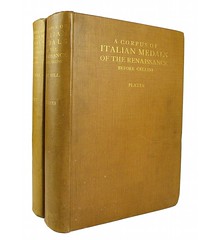
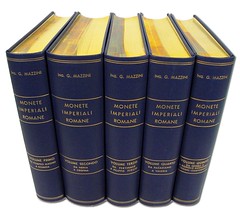
Lots 58 and 92
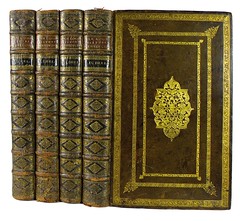
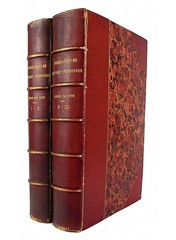
Lots 84 and 85
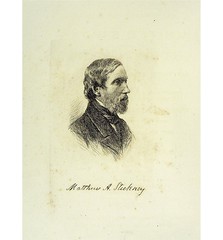
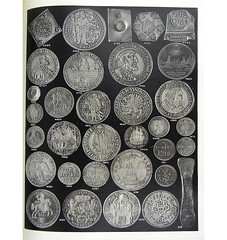
Lots 225 and 228
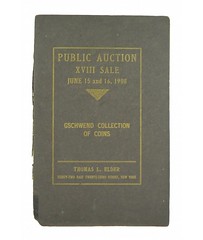
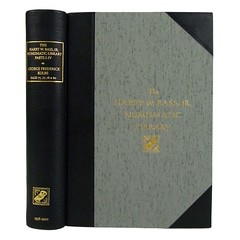
Lots 253 and 315
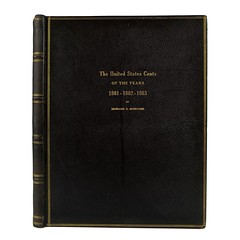
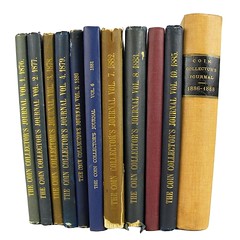
Lots 374 and 419
The sale has been posted to Kolbe & Fanning’s custom online biding platform at auction.numislit.com, where every lot is illustrated in color and where absentee bids can be placed at any time prior to the sale. The live sale will be conducted on the same site beginning at noon eastern time this Saturday, August 22. Printed copies of the catalogue have been mailed to those on our mailing list. For the convenience of browsing and keyword searching, a PDF of the printed version has been posted on the main Kolbe & Fanning website at numislit.com.
As a reminder, bidders may participate in this sale in a variety of ways. Please feel free to send us your bids in the regular mail or send us an e-mail at df@numislit.com . Give us a call or send us a fax. However, all absentee bids given to us must be received by the day before the sale. For those who prefer the experience of live bidding, please check out our live biding platform at auction.numislit.com. Register in advance of the sale and browse the lots at your leisure: all lots are illustrated in the online catalogue. Absentee bids can be placed online anytime before the lot is sold. Bids will be reduced as competition dictates and the privacy of your maximum bids is maintained.
Thanking you in advance for your bids,
Kolbe & Fanning

NEW BOOK: THE VALUE OF MONEY
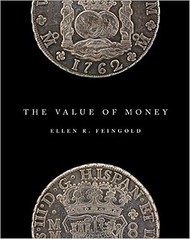 The Value of Money celebrates the power of using monetary objects to explore history. This richly illustrated book features over 175
objects from the Smithsonian National Museum of American History’s National Numismatic Collection. With objects from every inhabited continent,
spanning more than 2,600 years, this book showcases the National Numismatic Collection’s unique strengths, including the geographic and chronological
diversity of the collection and the stunning rarities it contains.
The Value of Money celebrates the power of using monetary objects to explore history. This richly illustrated book features over 175
objects from the Smithsonian National Museum of American History’s National Numismatic Collection. With objects from every inhabited continent,
spanning more than 2,600 years, this book showcases the National Numismatic Collection’s unique strengths, including the geographic and chronological
diversity of the collection and the stunning rarities it contains.
The companion volume to a major exhibition of the same name, this book examines the origins of money, new monetary technologies, the political and cultural messages money conveys, numismatic art and design, and the practice of collecting money. The Value of Money connects American history to global histories of exchange, cultural interaction and expression, political change, and innovation.
Hardcover: 172 pages
Publisher: Smithsonian Institution Scholarly Press (September 29, 2015)
Language: English
ISBN-10: 193562380X
ISBN-13: 978-1935623809
Price: $32.95
For more information, or to order, see:
The Value of Money
(www.amazon.com/The-Value-Money-Ellen-Feingold/dp/193562380X)
NEW BOOK: ROBERT SCOT - ENGRAVING LIBERTY
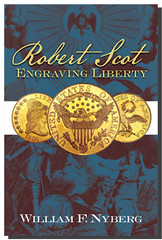 Robert Scot was without doubt the most prolific of colonial American engravers. His patriotic symbols inspired sentiments of rebellion,
unity, and liberty throughout the Revolutionary period, and on into the early 19th century. His highly-skilled engravings depicted important
historical events, such as a detailed map of the Siege of Yorktown, and included the original design for the Great Seal of the United States, various
medals, coins and paper currency. In addition, the first encyclopedia published in America was enhanced by his superb scientific engravings.
Robert Scot was without doubt the most prolific of colonial American engravers. His patriotic symbols inspired sentiments of rebellion,
unity, and liberty throughout the Revolutionary period, and on into the early 19th century. His highly-skilled engravings depicted important
historical events, such as a detailed map of the Siege of Yorktown, and included the original design for the Great Seal of the United States, various
medals, coins and paper currency. In addition, the first encyclopedia published in America was enhanced by his superb scientific engravings.
Until now, despite his significant achievements, this friend of the Founding Fathers has largely remained unknown to both historians and the general American public. William Nyberg’s extensive research of Scot and his world now allows his story to be told for the first time. This enthralling biography justifiably places Robert Scot among the most important and influential of early American artists.
“A superb work and important contribution to the study of early American numismatics. Nyberg's engaging narrative, built upon hundreds of primary sources, is equally authoritative and readable. A complete examination of Scot's engraving work, including coins, medals, paper money, seals and revenue stamps, is long overdue, and Nyberg is fully up to the task.” - Leonard Augsburger, co-author of The Secret History of the First U.S. Mint
About the Author
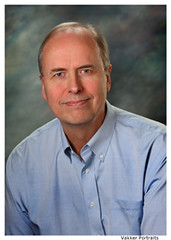 William F. Nyberg is a member of the Historical Society of Pennsylvania, the Library Company of Philadelphia, and the American Numismatic
Association. He learned the lost art of silversmithing at the Pratt Fine Arts Center. He has an MBA from Seattle University, works in the aerospace
industry, and is a member of the Institute of Industrial Engineers. He has previously published articles of numismatic research in the John Reich
Journal.
William F. Nyberg is a member of the Historical Society of Pennsylvania, the Library Company of Philadelphia, and the American Numismatic
Association. He learned the lost art of silversmithing at the Pratt Fine Arts Center. He has an MBA from Seattle University, works in the aerospace
industry, and is a member of the Institute of Industrial Engineers. He has previously published articles of numismatic research in the John Reich
Journal.
Format: 6" x 9" paperback on permanent paper, printed in the United States
Pages 252, including Preface and Acknowledgments, text, Chapter Notes, Appendix: Robert Scot Register of Engravings, Bibliography, Index,
About the Author
Illustrations: 76, including maps, copper plates, coins, paper currency, period photographs, period engravings, newspaper
advertisements and paintings
ISBN 10: 1-939995-09-4
ISBN 13/: 978-1939995-09-4 LCCN: 2015931682
Price: $24.95 (Bulk order rates are available upon request)
Endorsements
“A superb work and important contribution to the study of early American numismatics. Nyberg's engaging narrative, built upon hundreds of primary sources, is equally authoritative and readable. A complete examination of Scot's engraving work, including coins, medals, paper money, seals and revenue stamps, is long overdue, and Nyberg is fully up to the task.”
- Leonard Augsburger, co-author of The Secret History of the First U.S. Mint
" In this well-written and carefully researched book, William Nyberg has given life to a shadowy figure from the early years of the Philadelphia Mint. Not only was Chief Engraver Robert Scot a superb line engraver, but his efforts on our coinage have now emerged to give him a long overdue recognition. Those collectors interested in our early coinage will do well to obtain this fine reference for their library."
- Robert Julian, author of Medals of the United States Mint
"The wealth of new information found within this volume sheds new light, greatly enhancing the respect and admiration for the work of Robert Scot."
- Steve Tompkins, author of Early United States Quarters 1796-1838
For more information, or to order, see:
Robert Scot - Engraving Liberty
(http://americanhistorypress.com/index.php?main_page=product_info&cPath=1&products_id=37)
ROBERT A. VLACK, 1927 - 2015
(1/29/27) - 8/11/15
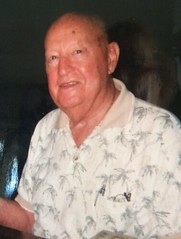 Bob was born and raised in the South Bronx, NY during the Depression years. He moved to Connecticut, entered the military serving during
WWII in the Army as a medic, entered college under the GI Bill and did his graduate studies at Northern University and MIT. Being the proverbial (and
literal) "rocket scientist", Bob used his engineering skills working in ground support for the Titan Missile program. Later he was employed
as a Project Engineer for Western Electric.
Bob was born and raised in the South Bronx, NY during the Depression years. He moved to Connecticut, entered the military serving during
WWII in the Army as a medic, entered college under the GI Bill and did his graduate studies at Northern University and MIT. Being the proverbial (and
literal) "rocket scientist", Bob used his engineering skills working in ground support for the Titan Missile program. Later he was employed
as a Project Engineer for Western Electric.
At the age of 50, he retired from the 9:00 - 5:00 workforce and became a coin dealer. It was at this time that he served in the New Hampshire House of Representatives as a Legislator.
Bob started collecting shortly after WWII and later decided to specialize in collecting and studying the coinage and paper money of our colonial times. In the 1950s, he started doing serious numismatic research and over several decades he constructed photographic plates of colonial coin images, assisting the collector in identifying die varieties. Several colonial coin die varieties are known by the Vlack numbering system, including the coinage of Machin's Mill and St. Patrick Halfpence (among others). He wrote articles in various numismatic publications, including eighteen of them in the Colonial Newsletter.
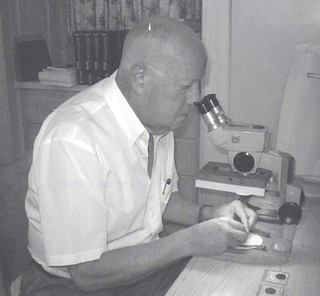 His first book, Early American Coins, was published in 1965. In 2001 he published Early North American Advertising Notes and
in 2004 he published The French Billon Coinage in the Americas (a C4 publication). This book won the Fred Bowman Literary Award by the
Canadian Numismatic Research Society in 2005. Bob also was involved in the editing and rewriting of many numismatic books we enjoy today. In 2007,
the Colonial Coin Collectors Club awarded him its Lifetime Achievement Award.
His first book, Early American Coins, was published in 1965. In 2001 he published Early North American Advertising Notes and
in 2004 he published The French Billon Coinage in the Americas (a C4 publication). This book won the Fred Bowman Literary Award by the
Canadian Numismatic Research Society in 2005. Bob also was involved in the editing and rewriting of many numismatic books we enjoy today. In 2007,
the Colonial Coin Collectors Club awarded him its Lifetime Achievement Award.
Bob was active in, and a member of, many numismatic organizations. He was president of the Collectors Club of New England and La Societe Americaine. In addition to his writings, he gave educational presentations as the featured speaker for many clubs and numismatic organizations.
He is survived by six children, thirteen grandchildren and 11 great-grandchildren.
On a personal note, Bob was always willing to help collectors from the novice to the expert. On the bourse floor, his table was never empty - between helping customers with an inventory that had something for everyone, or assisting a researcher, or educating a collector. Bob always had a smile on his face and a welcoming demeanor. His passion for numismatics was addictive. He will be missed by many and remembered through the ages for his numismatic contributions.
Ray adds:
Bob has run the race and crossed his finish line. Every year we lose great numismatists who have had such an influence on our hobby. Let us appreciate those that are still with us and thank them for their contributions when we can. When I had (as C4 President) the privilege of informing Bob that he was being awarded the C4 Lifetime Achievement Award, I had to do so in a phone call as he lived in Florida at the time. I could hear the tears in his voice as he was thanking me. It has been my experience that few in our hobby make their contributions to win awards, but when an honor is bestowed, it is tremendously appreciated.
BILL ANTON HAS PASSED
Ray Williams writes:
I had a friend return from the ANA Convention and mention that he heard a rumor that Bill Anton had passed away. I checked and there was no obituary I could find online in New Jersey newspapers. I checked with a number of people I thought would know and received confirmation that Bill passed about two weeks ago. No one had any details.
Bill had been ailing for quite a while and this is not a surprise. His name is familiar to all collectors of New Jersey Coppers. He was a significant part of the first NJ copper Symposium (April 20, 1991), authored a book with Bruce Kesse about counterfeit British Halfpence, and wrote a major NJ Copper article in the Colonial Newsletter. Others knew Bill much better than I and I hope they'll share some stories.
VASILIJS MIHAILOVS, 1978-2015
Vasilijs Mihailovs was born in Riga, Latvia on May 15, 1978 and he passed away on August 11, 2015 during an medical operation in Latvia.
He first came to Thailand on a UNESCO Scholarship to study at Kasetsart University. Then he went back to his home country and graduated summa cum laude from the University of Lativia with a Masters in Philippine Asian Studies in 2005. He returned to Thailand and taught at Silapakorn University from 2003 to 2011. Then he was employed at Bangkok International Associates from 2011 to 2015.
Vasilijs was a specialist in Thai, Maldives, Dutch colonial and related coinage, and a Life Member of the Numismatic Association of Thailand.
The owner of Bangkok International Associates is Ronachai Krisadaolarn and he is an advanced collector in Thai and neighboring country's numismatics. Ronachai and Vasilijs teamed up and wrote Siamese Coins from Funan to the Fifth Reign. It took many, many years of work to produce it. It won the International Association of Professional Numismatists (IAPN) Book of the Year and Vasilijs and Ronachai were awarded their gold medals on January 19, 2014. Their book is now the standard in the field of Thai coinage.
Vasilijs will be greatly missed by numismatists in Southeast Asia and worldwide.
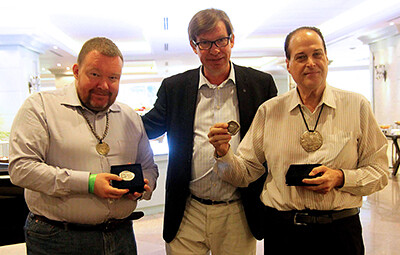
Vasilijs (left) and Ronachai (right) are displaying their I.A.P.N. Book Prize Medals
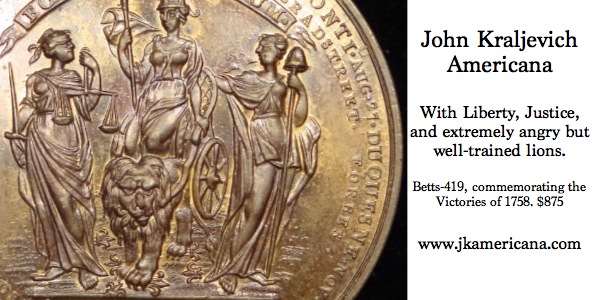
NOTES FROM E-SYLUM READERS: AUGUST 16, 2015
Was Hans Schulman Responsible for 'Hogmouth'?
Bob Leonard writes:
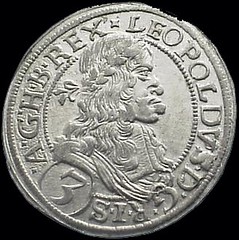 I believe that the "Hogmouth" sobriquet was thought up by coin dealer Hans M. F. Schulman, probably in the 1950s, as a way to get
a better price for these common coins. If you do a Google search, you quickly notice that ALL of the "Hogmouth" references are to coins;
none are to any conventional biography of him, much less any Austrian mentions. "Hogmouth" appears in the Wikipedia article, but only in
reference to a coin. Leopold I was never called this during his lifetime.
I believe that the "Hogmouth" sobriquet was thought up by coin dealer Hans M. F. Schulman, probably in the 1950s, as a way to get
a better price for these common coins. If you do a Google search, you quickly notice that ALL of the "Hogmouth" references are to coins;
none are to any conventional biography of him, much less any Austrian mentions. "Hogmouth" appears in the Wikipedia article, but only in
reference to a coin. Leopold I was never called this during his lifetime.
To read the earlier E-Sylum article, see:
BEST. ROYAL. NICKNAME. EVER. (www.coinbooks.org/esylum_v18n32a22.html)
More Chess-Playing American Numismatists
Paul Bocso writes:
I was rated as high as 1892. Charlie Adkins may have made Master (2200). The best is Sid Belzburg (Canadian but has lived in NYC), a fairly good friend of Gary Kasparov. Steve Goldstein plays the game and collects chess medals. The Marshall Chess Club, when I was a member, had some medals among its memorabilia.
Ralph Dubisch writes:
Not sure if I qualify, as I'm more of a numis-playing chessist. I'm a FIDE Master of chess, and something of a collector/investor in coins, though I am a life member of the ANA.
Eric Holcomb forwarded the E-Sylum link to me. He's a serious numismatist, club-level chess player, and businesses manager of Northwest Chess magazine, winner of the Best State Magazine award by the Chess Journalists of America in 2014 and 2015.
John Dale Beety writes:
Recently I saw myself mentioned by Pete Smith in The E-Sylum as a former junior chess champion. I'd like to offer a bit of confirmation and clarification.
I played chess more-or-less casually until high school, when I started taking it more seriously. I was a two-time Indiana State Junior Blitz Chess Champion -- in "blitz chess" one must make all moves in five minutes or less and going over usually means a loss.
I won my championships in 2001 and 2002, at ages 15 and 16, and I briefly was in the Top 20 Juniors list of the now-defunct World Blitz Chess Association. At age 17, as a college freshman, I tried a last defense of my title, but I came in third and deservedly so. That was my last chess tournament; I didn't have the time or talent to compete at the senior level and I knew it, so I retired with my happy memories of chess intact.
I've attached a photo of me at age 30, wearing the medal I earned at 16. I'm also holding a coin from the Eric P. Newman collection as a token of a more enduring hobby love.
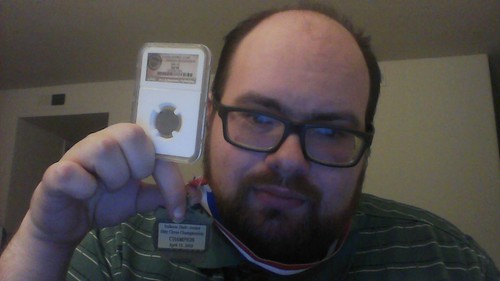
To read the earlier E-Sylum article, see:
QUERY: CHESS-PLAYING AMERICAN NUMISMATISTS SOUGHT
(www.coinbooks.org/esylum_v18n32a14.html)
More Double Struck Buffalo Nickels
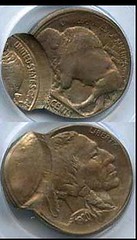 Saul Teichman writes:
Saul Teichman writes:
With regard to double struck buffalo nickels like the one in the ANA sale, here are a few more and there are likely others. Error coins have always been an unappreciated area of numismatics.
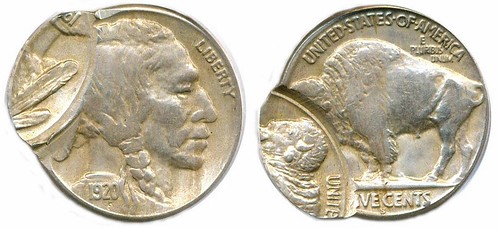

To read the earlier E-Sylum article, see:
NOTES FROM E-SYLUM READERS: AUGUST 9, 2015 : 1919 Double Struck Buffalo Nickel
(www.coinbooks.org/esylum_v18n32a09.html)
More on the American Art Museum Medal Collection
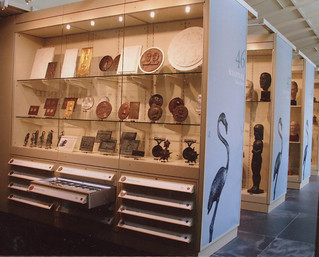 Two weeks ago you made note of the medals exhibit at the Smithsonian American Art Museum in Washington DC. F and 9th St. Here is a photo I
took in about 2007.
Two weeks ago you made note of the medals exhibit at the Smithsonian American Art Museum in Washington DC. F and 9th St. Here is a photo I
took in about 2007.
It is in the annex building across the street from the Spy museum, not in the building on the Mall. Luce Foundation Center, 4th Floor., in a west corner of the 19 Century building which has a central atrium area. It is a great conversion.
The medals are mostly US late 19th and early 20c artists, and depict plasters, models and some final pieces. Of note are some of Paul Manship's plasters and models for early Military Medals as well as some of his other cast works.
The open display is packed, and the trays at the bottom are pull out, and hold many additional medals and plasters. All with limited information on the cards.
Some of the galleries are currently under renovation, says the website. So this may have all changed.
To read the earlier E-Sylum article, see:
SMITHSONIAN AMERICAN ART MUSEUM MEDALS
(www.coinbooks.org/esylum_v18n31a20.html)
MULTIPLE ORGANIZATIONS PROVIDE AUTHOR GRANTS
In last week's item about Central States Numismatic Society author grants, CSNS Education Director Ray Lockwood wrote:
"We know of no other numismatic organization that is funding numismatic research and/or publications."
Society of Paper Money Collectors Treasurer Robert R. Moon writes:
The Society of Paper Money Collectors (SPMC) has been in the forefront of supporting research and publications for over FORTY YEARS when, starting in the 1970's, it helped authors front the costs of publishing updated references on Obsolete Bank Notes. Over the years, about 20 new State references have been published thanks to full or partial funding from SPMC. In addition to Obsoletes, we have helped fund the publishing of several books on National Bank Notes including M. Owen Warns "The Nevada Sixteen" and Peter Huntoon's "Territorials".
Also, as Treasurer of SPMC for the past ten years, I can personally say that, at the direction of our Board of Governors, I have written numerous checks for thousands of dollars to fund research of various types of paper money. Most recently, I sent a check for $5,000 to Peter Huntoon for his on-going research at the National Archives.
I checked with Ray Lockwood, who writes:
You are correct in stating that our grants are broad and open to any numismatic author.
To read the earlier E-Sylum article, see:
CENTRAL STATES AUTHOR GRANTS (www.coinbooks.org/esylum_v18n32a13.html)
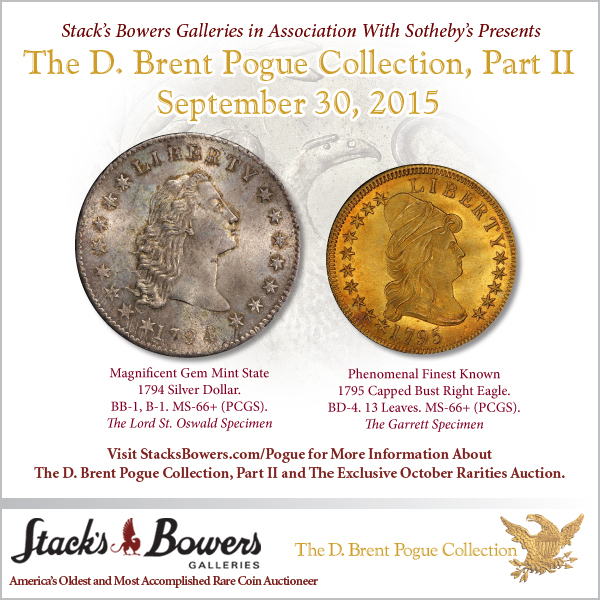
MORE ON RIDDELL'S 1845 MONOGRAPH
Gary Beals writes:
Holy Gutenberg — I got some book-learnin’ to do about book printing! Thanks Bob Leonard, you caught me asleep at the switch on that one — and I still don’t quite understand what Riddell did. Somehow he took the relief images of coins and made them simply up or down images to print. And I accidently insulted Riddell by saying he didn’t want to spend the money on line art when he was actually pioneering something quite new and valuable.
My ignorance of pre-photographic printing techniques leaves me in awe of you grand folks, both numismatists and book scholars.
As I work on El Numiscadero, my Spanish-English numismatic dictionary I find both the words imprenta – to print – and impronta – to make a rubbing, I think! With Bob’s observations I can see there are still some details to be worked out.
George Kolbe writes:
In response to Bob Leonard’s E-Sylum contribution concerning the illustrations in the 1845 Riddell "Monograph of the Silver Dollar,” I do not have an original at hand. The following footnote, which I hope is useful, follows the one sold in 2007 in Kolbe Sale 104:
"John Leonard Riddell (1807–1865) was Melter and Refiner at the Branch Mint from 1838 to 1849; from 1860 to 1863 he served as Postmaster of New Orleans. The illustrations in this valuable work are most unusual. Though having the superficial appearance of rubbings they were, according to the author, made from “metal types adapted for printing, indirectly from the coins themselves, which, if they do not always make a handsome print, give a perfectly correct, and I think, satisfactory representation.” Apparently, the resulting method of printing necessitated the impression on only one side of each signature. Despite apparent widespread initial distribution of the Monograph of the Dollar, sales must have been small, judging from the number of copies still extant. It is a pity. Riddell’s charming illustrations, if appearing to be a bit crude, are amazingly accurate and are actually the most realistic depictions of coins to appear in print up to that time. His unique process surpassed medallic ruling machine illustrations and was not superseded until the use of photographic coin illustrations became feasible in the 1870s. Beyond its obvious interest to American numismatists, Riddell’s Monograph is still widely consulted by collectors of Mexican and Latin American eight reales."
My recollection is that the Riddell illustrations in the reprint are of considerably lower quality than those found in the original (consistent with most reprints done before the wonders of computer imaging technology).
Riddell’s text seems to suggest that the text and plates were printed in the same press run but I never entertained the possibility that two runs were done and, accordingly, never looked for any such signs. Perhaps a Big E reader fortunate enough to possess an original Riddell can provide light on the topic.
Dan Hamelberg writes:
I'm not sure how to tell if the original Riddell was printed in two runs. I have two originals, and one reprint, and the illustrations and printing in the reprint are of lower quality than in the original. As I look over the original, the illustrations and descriptions below each are printed on one side, and appear to be consistent with each other. There are good margins around the coin illustrations, so I guess there would be a possibility of two print runs as the placement of the coin illustrations would not have to be terribly accurate to fit the page space allotted.
In Riddell's "Concluding Remarks," he states that "After many trials, overcoming successive difficulties as they presented themselves, I at length succeeded in preparing metal types adapted for printing, indirectly from the coins themselves, which, if they do not always make a handsome print, give a perfectly correct, and I think, satisfactory representation." He goes on to say "....all these matters, and the details of the plan itself, I shall give an account at a future time, in a more appropriate place."
I'm not sure if he ever got around to an explanation as I have never seen any such information in print. So, I cannot give a definite answer to the question of two print runs, but it would appear from the original copy that the illustrations and descriptions are fairly uniform in appearance.
To read the earlier E-Sylum article, see:
HOW RIDDELL'S 1845 MONOGRAPH ILLUSTRATIONS WERE MADE
(www.coinbooks.org/esylum_v18n32a06.html)
HENRY CHAPMAN'S SECRETARY ELLA B. WRIGHT
John Lupia writes:
Perhaps this item may be of interest to you and our readers. A few years after Ella Wright was choked, gagged and tied up during a robbery at the Chapman's coin shop, Tom Elder reported a similar robbery at Wayte Raymond Inc., and thought the two burglaries were perpetrated by the same gang.
Ella B. Wright (1877-1952) was born at Philadelphia on June 11, 1877 the daughter of John B. Wright, a Clerk of the City of Philadelphia and his wife Mary E. Early. According to the 1900 U.S. Census she lived with her parents, maternal aunt Ella E. Early, and two sisters : Mary and Alice, and worked as a typist (type writer).
She began working for Henry Chapman soon after he had dissolved his partnership with his brother Samuel Hudson Chapman on August 17th 1906. She would eventually work for Henry and his wife Helen for over forty years.
On January 28, 1941 Ella B. Wright was choked, gagged and tied up by three armed robbers who stole mainly Roman and Greek coins and rare stamps valued at $20,000 from the Henry Chapman Old Coin Shop. Chester Times, Tuesday, January 28, 1941 Front Page; Gazette and Bulletin, Wednesday, January 29, 1941, front Page. A few years afterwards Thomas Lindsay Elder wrote to Ella about the robbery of $10,000 at Wayte Raymond's office telling her he thought it was the same gang that robbed her (see Figs. 1 & 2).
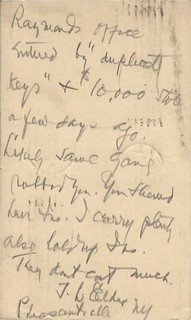 The reverse of the ... postal card with the message : "Raymond's Office entered by "duplicate keys" & $10,000 stole a
few days ago. Likely same gang robbed you. You should have Ins. I carry plenty also hold up Ins. They don't cost much. T. L. Elder Pleasantville,
N.Y."
The reverse of the ... postal card with the message : "Raymond's Office entered by "duplicate keys" & $10,000 stole a
few days ago. Likely same gang robbed you. You should have Ins. I carry plenty also hold up Ins. They don't cost much. T. L. Elder Pleasantville,
N.Y."
She ran the firm of Henry Chapman Numismatist from the time of his death on January 4, 1935 until 1948. She died on July 13, 1952 of pneumonia and arteriosclerosis. She is buried in Northwood Cemetery, Philadelphia. In the June issue (1954) of The Numismatist S. W. Freeman wrote a few lines of reminiscences about Ella giving him his start in coin collecting in the 1920’s.
To read the complete article, see:
WRIGHT, ELLA
B (https://sites.google.com/site/numismaticmallcom/encyclopedic-dictionary-of-numismatic-biographies/wright-ella-b)
THE BOOK BAZARRE
THE 1795 REEDED EDGE CENT
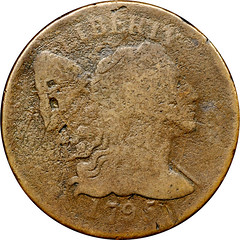
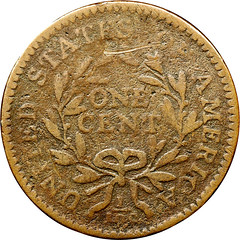
A coin dealer's list in 1964 offered a 1795 Sheldon-79 Reeded Edge cent for sale. That listing prompted large cent researcher Del Bland to record the coin in his Condition Census for the variety, although the coin was unseen at that time, and has been recorded as an "untraced" specimen in every published census since that time.
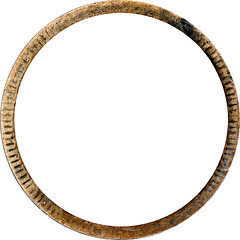 The Reeded Edge cent variety was discovered in 1862 when an example was described with a "Milled Edge." A second example appeared
in an 1890 W. Elliot Woodward catalog, and is now part of the ANS Collection. The third example, and currently the finest known, was discovered in
1915 and grades VG8. Six others have been located since that time, and the current House of Davis McKinney specimen brings the census to 10 known
examples.
The Reeded Edge cent variety was discovered in 1862 when an example was described with a "Milled Edge." A second example appeared
in an 1890 W. Elliot Woodward catalog, and is now part of the ANS Collection. The third example, and currently the finest known, was discovered in
1915 and grades VG8. Six others have been located since that time, and the current House of Davis McKinney specimen brings the census to 10 known
examples.
The 1795 S-79 Reeded Edge cent is the rarest of nearly 300 Sheldon-numbered varieties, and it is rarer than 14 of the Sheldon NC varieties. The obverse and reverse dies of the famous Reeded Edge large cent were not used for any other varieties in 1795, simplifying the authentication process. NGC has certified this piece as VG Details, Corrosion. The present example is the fourth of 10 different examples that Heritage Auctions has handled. There have been 11 different firms or individuals who have handled or owned two different specimens. Just two people, Dr. William H. Sheldon and Denis W. Loring, have owned three different examples. Heritage is the only entity to handle four different examples of the 1795 Reeded Edge cent.
The purpose of the edge reeding is unknown, although past students of the series have speculated that the reeding served as an anti-counterfeiting device. About half of the original edge reeding remains visible on this example.
To read the complete lot description, see:
1795
1C Reeded Edge, S-79
(http://coins.ha.com/itm/large-cents/1795-1c-reeded-edge-s-79-b-9-low-r7-corrosion-ngc-details-vg-our-eac-grade-good-4/p/1231-13001.s)
ROBOTS INVADE SAN FRANCISCO MINT
 The San Francisco Mint has completed installation of a robotic loop assembly system that triples the speed of packaging Proof coins into
plastic lenses for special collector sets.
The San Francisco Mint has completed installation of a robotic loop assembly system that triples the speed of packaging Proof coins into
plastic lenses for special collector sets.
The system, developed by the Mint’s engineering team in conjunction with the manufacturer, Farason Corp., Coatsville, Pa., gives the San Francisco Mint the ability to fill coin lenses at the rate of 1,800 lenses per hour, versus the previous 600 per hour, a Mint official said.
The system replaces a labor-intensive system installed in 1999 that required significant manual inspection of coins and plastic lenses, checking for damage that would prompt removing the coins or lens from the assembly system.
The new robotically controlled digital inspection assembly inspects each coin and lens at each phase of the assembly operation. Coins and lenses can be rejected if they fail to meet quality control specifications. If defects are found, the system will shut off for the defective item’s removal, and then restart.
(Each lens is composed of a top and bottom plastic enclosure and a cardboard insert with openings sized for the respective coins, which are robotically placed into them.)
Once the multistep operation is complete, the finished lenses are moved by automated trolleys to the next station where they are loaded for placement into the full-color cardboard storage boxes before final shipment in delivery boxes.
Don Penning, the San Francisco Mint’s industrial manager for packaging, said the digital visual detection equipment will, at every entry interval, inspect the coins and lenses for defects. A final quality control inspection is conducted at the end of the line when the finished lenses exit the assembly loop.
Where the previous assembly system required three full-time operators, the new system requires only two workers to keep the system stocked with sufficient top and bottom plastic lenses, cardboard inserts, and coins. The system will shut down if any station from which coins or lenses are fed runs out.
To read the complete article, see:
Robots invade San
Francisco Mint for assembling plastic lenses for Proof coin sets (www.coinworld.com/news/us-coins/2015/08/
san-francisco-mint-triples-proof-set-assembly-with-robots.html)
LOCAL COVERAGE OF THE 2015 CHICAGO ANA CONVENTION
"We'll start with the small stuff -- $5,000 and $10,000 bills," quips Donn Pearlman, a former member of the board of governors for the American Numismatic Association, which sponsors the massive coin and currency show going on through Saturday at the Donald E. Stephens Convention Center in Rosemont.
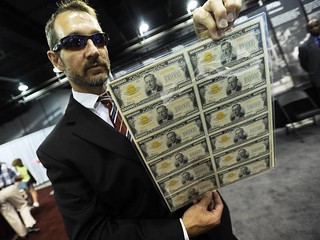 Those magnificent bills only whet the appetite for the $100,000 bills. Kevin Brown, marketing manager with the Department of the
Treasury's Bureau of Engraving and Printing, lifts a dozen of the bills worth $1.2 million from the glass case unlocked by Karen Smith, a
marketing manager with the numismatic group.
Those magnificent bills only whet the appetite for the $100,000 bills. Kevin Brown, marketing manager with the Department of the
Treasury's Bureau of Engraving and Printing, lifts a dozen of the bills worth $1.2 million from the glass case unlocked by Karen Smith, a
marketing manager with the numismatic group.
"These were only used for the Federal Reserve Banks," Brown says of the 1934 bills, which sport the likeness of President Woodrow Wilson. The largest denomination ever printed, the $100,000 bills are worth a fraction of what lurks under the glass in the next locked display case.
"One billion dollars!" Brown says slowly, holding his right pinkie to his mouth in a dead-on impression of Dr. Evil from those "Austin Powers" movies, before gently cradling two $500,000,000 Treasury notes. In charge of the "Billion Dollar Showcase," Brown still lightens the mood. Collecting coins and currency should be fun, he says.
"I have the best collection in the world. Whatever we've printed, I have," says Brown, who is surrounded by gobs of money at his office but generally can't bring his work home with him. "I collect the stories people have. They get people asking who's on money and why."
One of the most popular items is a 1913 Liberty Head nickel worth an estimated $2.5 million, says Pearlman, who retired from his 25-year career as a newsman with WBBM-AM radio and Channel 2 TV. Milwaukee resident J.V. McDermott used to carry that nickel around in his pocket, whipping it out to win bar bets when he'd produce the documentation about its worth, Pearlman says. After McDermott's death in 1966, the coin was purchased at an auction for $46,000 and donated to the American Numismatic Association Money Museum in Colorado.
The nickel shares a display with a legendary "King of U.S. Coins" 1804 silver dollar, which actually was struck in the 1850s as part of diplomatic trade mission gifts to the king of Siam and other Asian leaders. Only six are thought to exist today, and this one is insured for $4 million.
Even if a thief could swipe a $100,000 bill, he wouldn't be able to use it at Wal-Mart. Still, Brown says, the World's Fair of Money has armed guards, cameras and extensive security. He is coy when it comes to details about how he got his billion-dollar display to Rosemont.
"Securely," Brown says. "Very securely."
To read the complete article, see:
Constable: $1 billion is yours -- but only to see -- at show in
Rosemont (www.dailyherald.com/article/20150812/news/150819725/)
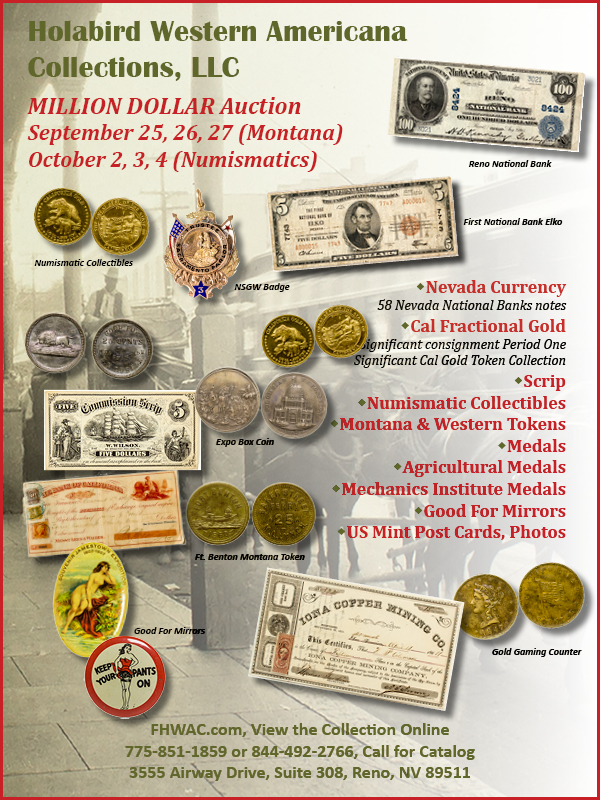
WAYNE’S NUMISMATIC DIARY: AUGUST 16, 2015
WEDNESDAY, AUGUST 12
My travel to Chicago was thankfully uneventful. My flight arrived a little early and soon I was on a shuttle to the Rosemont Hilton. It was
about 9:30 am, too early to check in, so I checked my bag and walked across the street to the convention center.
Exhibits
I stopped at the ANA booth and picked up my Glenn Smedley ribbon, then sat at a nearby table to assemble my badge. Next I spotted a doorway
with a security guard that looked like it led to the bourse, and went inside. It turned out to be the exhibit area.
No problem - I had time and ended up looking at nearly every exhibit. I was most pleased to see FOUR exhibits in the numismatic literature category. I took some photos and we'll have more on these in future issues. Titles included:
- Publications by Charles Steigerwalt
- Roman Coins and Their Values
- Buy the Book Before the Coin
- Loubat's Vanities
While looking at the exhibits I ran into Fred Schwan, Bryce Doxson, and Paul Hybert. I also spotted ANA Board member Ralph Ross. As much as I loved the literature exhibits, I broke into a smile when I saw one titled, "Collecting Twentieth Century Coins in the 1940s" The cases were filled with coins and their companying envelopes from Tatham Stamp & Coin Company of Springfield, Mass. They were before my time, but I fondly remember receiving coins on approval from Littleton Stamp & Coin in my preteen years. That must be what triggered my reaction. I filled out my Rodger E. Hershey People's Choice Award ballot to vote for the exhibit. I knew Rodger from my Pittsburgh days, and thought he would have been pleased with the exhibit as well.
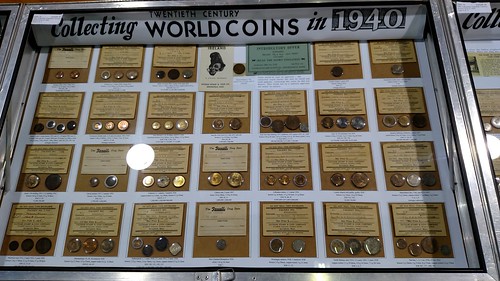
I found many quality exhibits featuring rare and interesting material. Perhaps I'll write about some in another article. But I felt my trip had already been worth it.
Whitman
Eventually I found the main bourse floor. As I approached the Whitman booth I spotted none other than Red Book editor Ken Bressett signing
a book for a customer. Soon I was talking with both Ken and Whitman's Dennis Tucker. Dennis introduced me to Littleton Public Relations
Manager Jill Kimball and Whitman’s senior associate editor Caitlyn Trautwein.
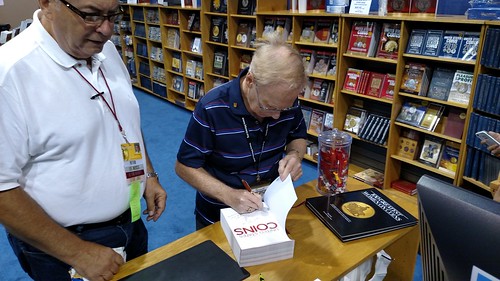
Ken Bressett signing a "Mega Red"
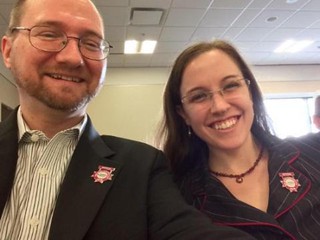
Here's a shot of Dennis and Caitlyn From Dennis' Online Blog
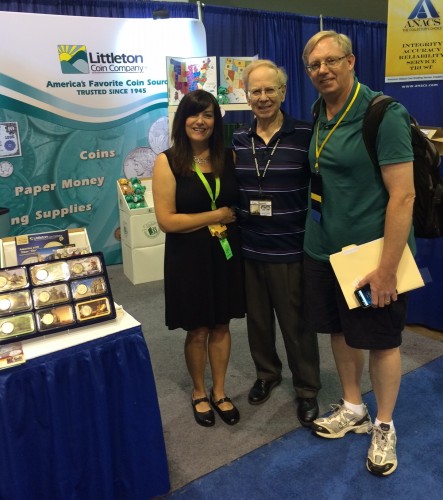
Jill Kimball, Ken Bressett, Wayne Homren
When someone asked what exhibits I'd seen, I told everyone about the "Collecting in the 1940s" exhibit I'd enjoyed so much. And wouldn't you know it - Ken Bressett told us he'd once worked for the Tatham Coin Company attributing ancient coins - he'd typed up descriptions on Tatham envelopes! And Jill told us that Maynard Sundman had modeled the Littleton company after the mail order format of Tatham. Those little envelopes have had impact down to the present day.
Sundman Lecture Luncheon
Next Dennis, Caitlyn, Ken and I wandered upstairs to join the Maynard Sundman Lecture Series Luncheon. Also at our table were Ted Lemba, David Sundman, Jill, David Lisot and Ken.
I ended up sitting between Caitlyn and former ANA President Gary Lewis. Here's a shot Dennis took
of our table. Not shown are me, Gary Lewis and (of course) Dennis. That's Caitlyn in the foreground bottom right.
The food was quite good for hotel fare. Afterwards David got up and gave a short talk on the history of the lecture series, and thanked all the speakers and organizers. He also mentioned the Tatham Stamp & Coin connection.
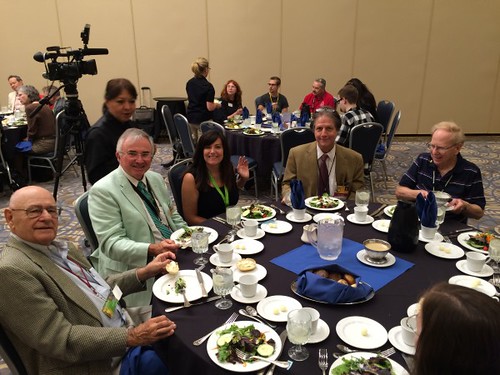
To read Dennis' complete articles, see:
2015 ANA
World’s Fair of Money: Tuesday, August 11—Greenbacks, Red Books, and Lots of Silver
(news.coinupdate.com/2015-ana-worlds-fair-of-money-tuesday-august-11-greenbacks-red-books-and-lots-of-silver/)
2015 ANA
World’s Fair of Money: Wednesday, August 12—Barbers and Beards: A Match Made at the ANA
(http://news.coinupdate.com/2015-ana-worlds-fair-of-money-wednesday-august-12-barbers-and-beards-a-match-made-at-the-ana/)
PAN
Back down on the bourse floor I sought out the John Burns Memorial Library. Next door my old Pittsburgh friend Ed Krivoniak was manning the
Pennsylvania Association of Numismatists table, and I sat down for a chat. Ed's a longtime collector of New Zealand tokens, and
he's been adding some high grade pieces to his collection lately, duking it out in auctions with collectors in New Zealand. He's
also nearly completed a very impressive birth year set - 1949. Several pieces, particularly gold issues of that year have proved very hard
to find.
When Ed asked about my recent collecting purchases, I told him about my Carnegie Hero Medals and Labor Exchange currencies. Coincidentally, later in the week the Wall Street Journal had an article about alternative currencies currently being used in Greece, and a labor exchange scheme was mentioned. See the article later in this E-Sylum issue.
Examples of the new medal for Pope Francis' U.S. visit were for sale at the PAN table. It's a beautiful medal.
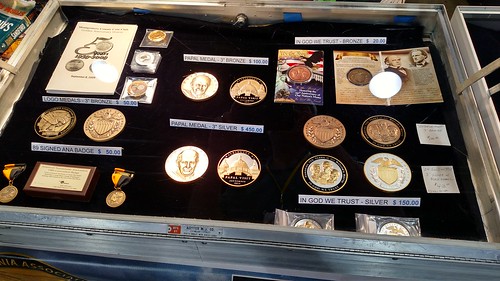
Later I spotted someone using the Burns Library to look up some information. I interrupted him for a chat. David Consolo of Cleveland, OH was attributing some Hard Times Tokens using the Rulau book.
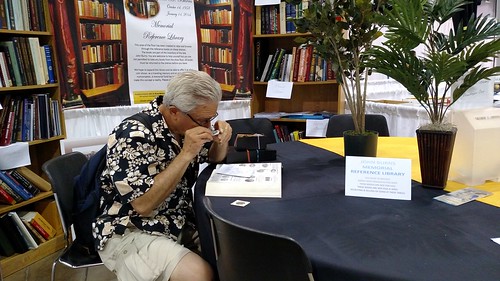
David Consolo at the John Burns Memorial Library
Some authors had donated copies of their books earlier in the day. Pat McBride sent this photo of Denis Loring donating an EAC Grading Guide.
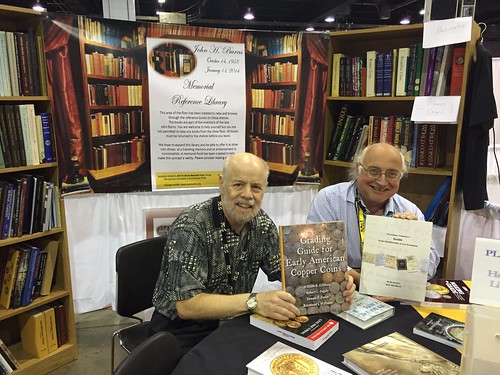
The Rittenhouse Table
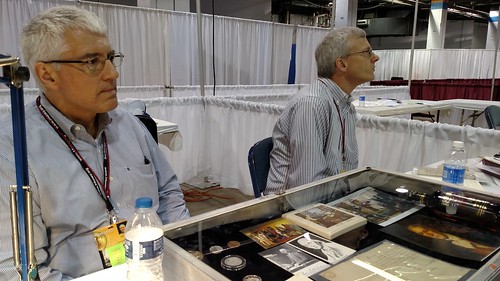
Joel Orosz and Len Augsburger
Joel Orosz and Len Augsburger were manning their "All Things Rittenhouse" table. The material was interesting, as was the company. Bob Julian was already there when I arrived, and later Paul Hybert stopped by.
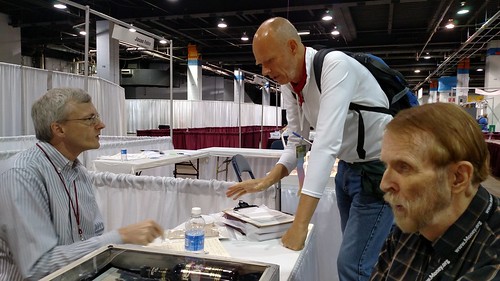
Len, Paul Hybert, Bob Julian
Other folks I chatted with included Andrew Harkness, Ken and Tom Hallenbeck, and Phil Carrigan. Andrew showed me the 3rd edition of his book on Agricultural medals. Although I stepped on my foot initially by calling Ken Tom and Tom Ken, I had a great conversation with the Hallenbecks and learned something very interesting - among Ken's collections is a knife owned by the infamous Alfred Packer (you can look it up).
Jeff Starck and Numismatic Mentors
I went back to check into my hotel for a while and returned about 4 o'clock to meet with Jeff Starck of Coin World. He'd
read my mention of the need for a "bridge" organization for numismatists who feel they're too old for Young Numismatist
programs but would still like to learn from more experienced numismatists. Jeff mentioned a program from the American Philatelic
Association.
I had given it some thought and decided that what these youngsters need more than another program is a mentor - someone who will take them under their wing and show them the ropes one-on-one. My first numismatic mentor was Glenn Mooney of Pittsburgh, followed by a host of great gentlemen (and ladies) of the Western Pennsylvania Numismatic Society. Ask any advanced collector or dealer in the hobby today, and I'll bet all of them have a story about a mentor who helped them along - role models to emulate. Readers: for our next E-Sylum issue, please send me stories about your own numismatic mentor.
Dinner
Soon a group of bibliophiles gathered. There were eight of us: me, Joel Orosz, Len and Debbie Augsburger, David Fanning, George Kolbe, John
and Megan Kraljevich. Joel had rented a big white limo, and we all piled in for a long ride to downtown Chicago.
The driver left us out in front of the restaurant. We descended steps to a private basement dining room. The food, wine, and of course the company were grand. There were jokes and stories running the gamut from hobby gossip, show experiences, research projects and great Internet bargains.
Howard Berlin
I'd planned to have a drink with Numismatourist Howard Berlin at the Hyatt. Luckily the trip back from downtown was faster sans rush
hour traffic and I got there about 9:45. Having had red wine all evening at dinner, I ordered one more.
We had a good conversation about past and future trips, the show, and mutual friends like Jules Reiver. A resident of Wilmington, DE, Howard lived close to Jules. We exchanged stories of our various visits to the Reiver household to shoot pool and talk numismatics. But after one drink it was time to call it a night.
THURSDAY, AUGUST 13
Thursday was my big day. I was so busy I didn't even take photos. Sorry!
10am: Numismatic Literary Guild Symposium
"The Internet's Impact on Numismatic Journalism"
Moderated by Charles Morgan of CoinWeek.com
David Lisot, Steve Roach, Ron Guth, Dave Harper and I were lined up to answer questions on the topic from Charles Morgan and the audience. The event was very well attended and filmed by David Lisot. I'll look forward to watching it on Coin Week.
I'm not sure we came up with any definitive answers on the future of numismatic journalism, but we indeed explored the Internet's impact. I illustrated the difference by recalling my visit to Coin World, where Beth Deisher showed me the CW printing press. It was a behemoth - a couple stories high and half a city block long. That's a huge capital investment, and that's not even counting the cost of paper, ink and pressmen to run it (or postage to ship the physical copies to readers).
When I started The E-Sylum, it was just little ol' me and a laptop, and my expenses were essentially zero. That's a monumental change in the economics of the business.
11:30 am: NBS Symposium, Room 22
"The Newman Numismatic Portal".
The main event for the convention for me and many others interested in numismatic research was our presentation on the Newman Numismatic Portal. The event was packed - standing room only. David Lisot also filmed this one, so those who couldn't be there will have a chance to view it online at some point.
Len Augsburger started off with a presentation on the goals and current state of the project. John Feigenbaum went next with a presentation on the software interface. Finally, I got up to discuss the current state and end goals for automation of the acquisition of new data.
Len described the NNP's relationship with Internet Archive, the nonprofit organization handling digitization. There's a press release in the works from Washington University in St Louis (WUSTL), where scanning is already underway for Eric Newman's library and other numismatic books.
Len described Internet Archive as the warehouse, the back end where the hard work is being done to digitize content and create appropriate database entries for each item. The NNP web site will be the storefront, the place where researchers will go to access the digitized content.
But a window into the warehouse is already publicly available at Internet Archive, and I promised to publish the address. Readers are encouraged to return to this page frequently, because new titles are constantly being added by the worker bees at WUSTL. Here's just one peek:

To access the complete NNP "warehouse: at the Internet Archive, see:
https://archive.org/details/newmannumismatic
1:00: NBS Board Meeting, Room 24
Look for more information on NBS Board actions in future issues of both our print and electronic publications. Two items I'd like to
highlight though: there will be no due increase next year, and work will begin to revise the NBS web site. We will be asking for financial
assistance to help with the cost. Me, Bruce Perdue, John Nebel and Elizabeth Benge will donate our time, but we need to hire a user
experience designer, which could cost $2,000-$2,500. Donors will be given an ad on the site; please contact me if you're interested in
helping out.
Why is this important? Google has announced a change in its search result ranking - web sites which are not mobile-friendly will be downgraded in favor of those which are. If we intend to stay relevant in today's tablet and SmartPhone environment, we have to keep up with the changes.
Fred Weinberg
Back down on the bourse floor I met Fred Weinberg at his table, where he enthused about The E-Sylum. I heard from Fred what I heard
from many people throughout the convention - it's their best (and often only) numismatic read of the week.
When I told Fred about our programs for Young Numismatists in Virginia, he began offering error coin after error coin from his bargain box. I left with a bag full of great error examples for our future events. These are a great way to teach newcomers about the mechanics of minting coins.
3:00 pm: John Burns Memorial Library Dedication: Booth 1959
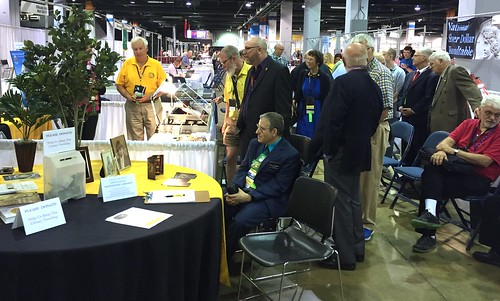
Image provided by pat McBride
I was running behind and had to rush over to the club aisle for the dedication of the John Burns Memorial Library. Sam Deep was presiding. It's a good think he brought a portable microphone - some fifty people jammed the aisle and nearby booths. Numismatic literature dealer John Burns had a lot of friends in the hobby. Sam, Pat McBride, myself and others all said a few words.
Sam related how he'd run into Kerry Wetterstrom at the airport, and Kerry had said he wasn't sure John would like the idea of a free library in his name. Sam asked why, and Kerry repeated one of John's favorite phrases when a browser had browsed too long in his numismatic literature sales booth - "This ain't no library!"
Larry Korchnak admitted to his own ruse to get access to John's books without being harangued to make a purchase. When John asked him to get him something from the concession stand, he said, "Why don't you take a break and get it your self - I'll watch your booth for you." John always took his time returning, leaving Larry plenty of time to browse and read.
John's book business was what you might call a "lifestyle business". It enabled him to be right where he always wanted to be, there on the bourse floor of coin conventions, meeting and talking with his numismatic friends. John was at home at the shows, and his library will continue that tradition. Sam deep told me afterwards that several people chipped in to help fund the transportation of the library to other coin shows. Please consider pitching in and making a donation, too - see the PAN web site for more information: www.pancoins.oeg.
4pm: (Money Talks, Room 6) Ed Moy, "Inside the US. Mint"
Former Mint Director Ed Moy gave a great talk about his five-year tenure at the Mint. It was a great view into the busy schedule, hard
work, and tough decisions involved. Afterward Ed and I walked over to the Hilton and found seats at a table in the lobby bar. We got caught
up on our personal lives and work projects. Ed has begun working on a new series of books with Whitman Publishing, so stay tuned.
I had a relaxing evening Thursday. I walked a couple blocks past the Hilton to a shopping and restaurant area that was already packed to an evening concert. People were bringing in folding chairs. I had a tasty dinner at a Mexican restaurant, then headed back to my room for a little E-Sylum work before bed. After dark I heard the loud booms of fireworks and wished I had stayed at the park to see them. They weren't visible from my room.
FRIDAY, AUGUST 14
Friday morning was like a Saturday for me, where my normal routine is to get up early and work on The E-Sylum a bit before the day
starts. I had breakfast when the hotel restaurant opened at 7 and spent the next couple hours on my computer.
It's a good thing I called Len Augsburger to ask him to lunch. I'd printed out last week's pre-diary article to use as my schedule, and I had a typo in the time of the NBS General Meeting - 1:30, not the proper time of 11:30. Sorry if anyone else relied on that. We agreed to have lunch after the meeting and I hustled over to the show earlier than planned.
One of the first folks I ran into was Allan Schein of Salt Lake City. He told me I'd won an award at Thursday night's NLG Bash, and he'd accepted it for me. I made arrangements to meet him at breakfast Friday to pick it up.
Allan won an award too, for his book, Mexican Beauty: Un Peso Caballito. Allan sports a mean mustache. He lamented that people rarely said anymore, "Hey, you look like Tom Selleck". Now they more often say, "Hey, you look like Wilford Brimley". His contribution to the evening's entertainment was his rendition of "The Grades They Are A Changing" to the tune of Dylan's "The Times They Are A Changing".
I'm an NLG member and was sorry to miss the Bash, but with a long dinner event Wednesday and the Banquet Friday, I needed a break to get some work done. People often ask how I manage to get The E-Sylum out each week. Well, I have to work at it, usually in short bursts in between the rest of my life.
John Dannreuther
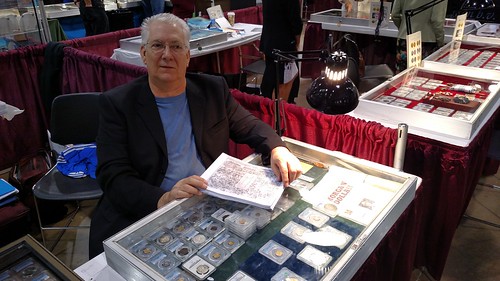
My next stop was John Dannreuther's table. After chatting about The E-Sylum a bit, he pulled out a photocopied book that made my jaw drop. The cover is hand labeled "Mint Cabinet Accounts". The title (also handwritten) is "Account of Expenditures for the Mint Cabinet from the Special Appropriation for specimens of Ores and Coins to be reserved at the Mint, also of Donations to the collection and Sundry Records". The ledger is the record of acquisitions for the U.S. Mint coin collection, now part of the National Numismatic Collection at the Smithsonian.
Long known to exist, the ledger was consulted by Walter Breen and others, but had been lost for twenty some years. John feared it had been stolen. He had asked a succession of Smithsonian staff including the late Dick Doty, but none were able to locate it. Until Ellen Feingold arrived. Ever persistent, he asked her about the ledger shortly after she arrived in the position. After a diligent search through the regular book stacks (everyone had been looking in the rare book section), she came across it wedged between and behind two other books. Eureka! Bless her for relocating this Holy Grail of American numismatic research. Inside are the keys to many a researcher's questions.
Bill Shamhart
My beeline to the Smithsonian table was interrupted by a stop at the Numismatic Americana table of Bill Shamhart. His eclectic and unusual
stock of offbeat numismatic items is a perfect match for E-Sylum reader tastes. I couldn't sell him on taking an ad since he
does most of his business at shows and with longtime clients rather than over the web. But oh, the stuff he had!
My attention was drawn to a group of molds for casting lead counterfeits of U.S. coins. He also had a large selection of counterfeit Buffalo Nickels and three-cent pieces. I'd never seen counterfeits of either, and here were a dozen of each. Steve Tompkins came by to drool (he'd love to buy one of the mold but hasn't been able to agree with Bill on a price). He showed me a copy of his new book (which looks marvelous) Early United States Half Dollars, Volume I 1794-1807. It illustrates quite a few counterfeits.
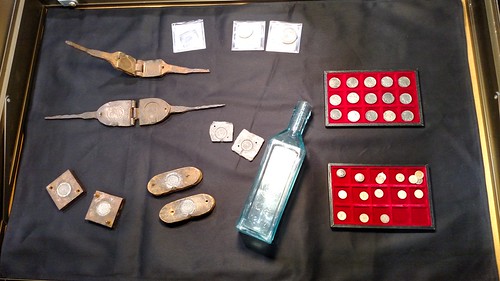
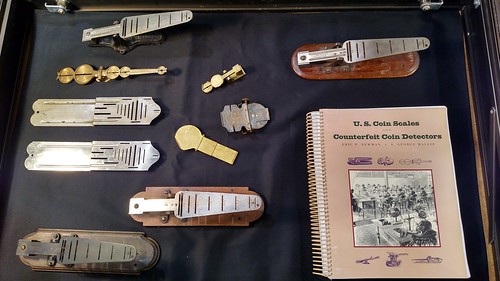
Dr. Ellen Feingold
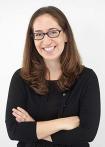 Next I visited the Smithsonian table and met Ellen Feingold. Here's her profile photo from the museum site. We talked about the new
exhibit and her catalog, which will be published soon. I also signed her up as an E-Sylum subscriber.
Next I visited the Smithsonian table and met Ellen Feingold. Here's her profile photo from the museum site. We talked about the new
exhibit and her catalog, which will be published soon. I also signed her up as an E-Sylum subscriber.
11:30 am: NBS General Meeting, Room 5
I was a couple minutes late arriving at the NBS General meeting. President Marc Ricard was in the middle of presenting the 5th George
Frederick Kolbe award medal. This wasn't on the agenda and came as a surprise. It was an even biggest surprise when he said it was
awarded to me!
This is a huge honor and I'm very grateful. The medal, which comes in a nice wooden box, was designed by Marc and his father and was struck by the Northwest Territorial Mint. These are some cellphone photos with a little glare; it's a wonderful piece. Thank you, NBS!
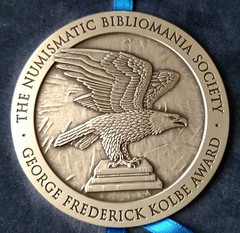
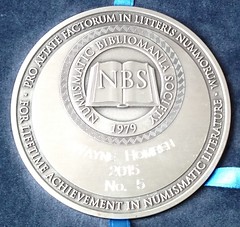
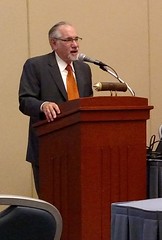 The main event was a talk by Dr. Donald Kagin about his new book, Profit from Gold and Rare Coins Now. Don opened with a discussion
of the finding and marketing on the Saddle Ridge gold coin hoard.
The main event was a talk by Dr. Donald Kagin about his new book, Profit from Gold and Rare Coins Now. Don opened with a discussion
of the finding and marketing on the Saddle Ridge gold coin hoard.
Lastly, the club held its annual fundraising auction, ably run by Dan Friedus and Dan Hamelberg, with Marc Ricard recording results. About $3,000 was raised for the Treasury. Many thanks to all the donors and bidders. I bought one lot of numismatic pamphlets for my ephemera collection.
1:00 pm: Lunch with Joel and Len
After the meeting Dennis Tucker took some photos of my medal. Joel Orosz, Len Augsburger and I went across the street to a steakhouse
restaurant for lunch. The haughty waiter was entertaining but the sandwiches were fine and filling - mine was blackened salmon. We spent a
lot of time discussing the Newman Numismatic Portal project.
Back over at the convention hall we ran into Dave Bowers in the lobby. Len asked for his permission to digitize and publish his Bowers and Ruddy and Bowers and Merena auction catalogs and publications in the Newman portal. He freely gave it, as he had earlier for my CoinLibrary.com project, which is now being incorporated into the Newman portal. We were ecstatic - Dave's material is a trove of numismatic information which will be quite valuable to future researchers.
3:00 pm: Colonial Coin Collectors Club, Room 44
I toddled upstairs to the Colonial Coin Collectors Club meeting. I had a little trouble locating the room, and so did Dave Menchell. But
after moving from the odd-numbered side to the evens, we quickly found the room. The meeting was already in progress with Dan Friedus
presiding over a conversation with the small group, which included Ken Bressett, Mark Borchardt, Ron Guth, Bruce Smith and Joe
Esposito.
4:00 pm: Bourse floor Ramblings
After the C4 meeting I called my wife to see what was happening on the home front. Out of the corner of my eye I noticed a blind man
approaching with a guide dog. Before I could hang up and ask if I could help, he was holding Howard Berlin's elbow as Howard guided the
pair across the convention center lobby toward their destination. Kudos, Howard!
Kuenker
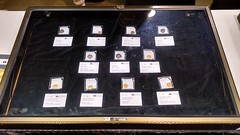 Back on the bourse floor I resumed my tour of the dealer tables. Having long marveled at the European coin rarities in the Kuenker sale, I
stopped by the company’s table and spoke to the dapper Fabian Halbich of Osnabruck, Germany. Many top lots from their upcoming sales were on display
along with material for purchase. He said they'd had a great show.
Back on the bourse floor I resumed my tour of the dealer tables. Having long marveled at the European coin rarities in the Kuenker sale, I
stopped by the company’s table and spoke to the dapper Fabian Halbich of Osnabruck, Germany. Many top lots from their upcoming sales were on display
along with material for purchase. He said they'd had a great show.

Doug Winter
Doug's a longtime E-Sylum fan and subscriber. We talked about his experience at the show (very good), as well as E-Sylum
advertising. Doug will likely become a new regular sponsor in the next few weeks. Thanks!
Tony Terranova
Next I stopped briefly at Tony Terranova's table. As we chatted I finally noticed a man in a suit sitting there. I took a closer look
and realized it was Jimmy Hayes, former Congressman from Louisiana and collector extraordinaire. We chatted about his only purchase at the
show (a medal with a rare reverse design), and how he'd become an E-Sylum subscriber: he was searching online for information
about a medal, and found an old E-Sylum article. This is a great example of what I'd mentioned in the NLG Symposium earlier in
the week. All of our back issues are archived online, and constitute a giant "honey pot" that attracts collectors and researchers
of the type of interesting items we discuss every week.
ANA Museum Exhibit

Next, I finally had some time to review the ANA's Museum exhibit. This travelling exhibit is marvelously done, perfect for introducing numismatic rarities to the general public. Kudos to curator Doug Mudd. I missed my chance to compliment him in person even though he was right there - he was answering questions from National Numismatic Collection curator Dr. Ellen Feingold.
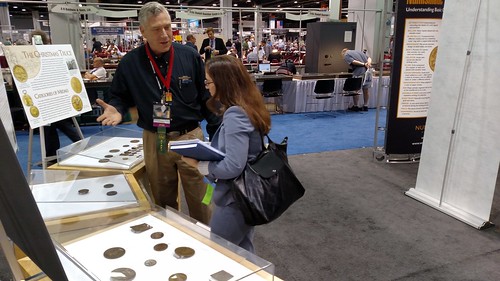
The Curators: Douglas Mudd and Ellen Feingold
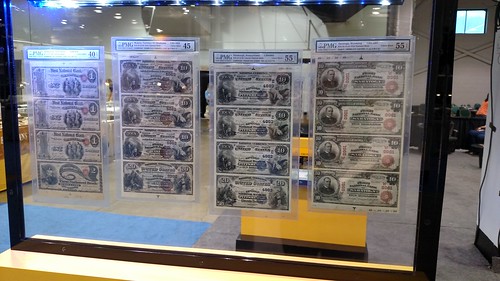
Dave Wnuck
Like Doug and Tony, Dave's my kind of dealer - he has an eye for great numismatic material with interesting history. One item that
caught my eye in his case was a beautifully gilt silver 1806 Agricultural Medal, together with its protective shell case. Here's how
Dave describes it on his web site.
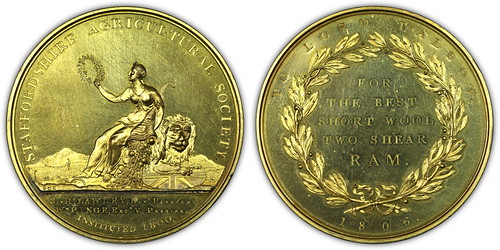
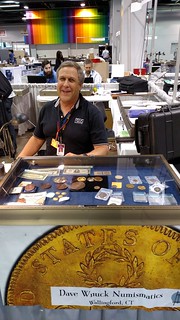 1806 Agricultural Medal. Choice Cameo Proof. Silver, Gilt. With Boulton Family Copper Shells. A large, impressive medal that looks and
feels like solid gold, but was expertly gilt when made. Includes custom made copper shells that have been silver plated on their interiors.
1806 Agricultural Medal. Choice Cameo Proof. Silver, Gilt. With Boulton Family Copper Shells. A large, impressive medal that looks and
feels like solid gold, but was expertly gilt when made. Includes custom made copper shells that have been silver plated on their interiors.
The obverse reads: Staffordshire Agricultural Society; the engraving under the exergue says: Sir Rt. Lawley Bart. President/Wm Pinge, Esqr. V. President/ Instituted 1800. The reverse reads: To Lord Talbot/For the Best/Short Wool/Two Shear/Ram/1806. Edge: Plain. Diameter = 48 mm (= 1 3/4 inches).
This medal comes with a letter of provenance upon request.
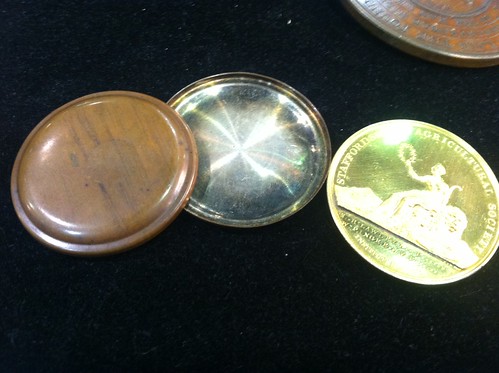
To read the complete item description, see:
1806 Agricultural Medal. (www.davewcoins.com/store/p356/1806_Agricultural_Medal.
_Choice_Cameo_Proof._Silver%2C_Gilt.
_With_Boulton_Family_Copper_Shells..html)
7pm: ANA Banquet (Hyatt)
I had gone back to my hotel to change into my suit and made it over to the Hyatt early for the ANA Banquet. The rest of the hotel was
jammed with Beatle Fest attendees. A makeshift band was playing "Eight Days A Week" in a corner off the main lobby. Not bad,
although they got moe off-key as the evening wore on. It was all I could do not to shout "Hey, look - there's Yoko Ono."
While waiting for the doors to open I enjoyed speaking with John and Nancy Wilson, Clifford Mishler, George Cuhaj, Eric Schena, Dave Schenkman and many others. I enjoyed meeting for the first time Civil War Token Society officer Susan Trask. She said, "I feel like I know you really well - I take you to bed with me every Sunday night." That was the funniest line I'd heard all week. Luckily her husband was right there and my wife doesn't read this newsletter (as far as I know, anyway).
The Cult of the Biblio-Tie was a fizzle this year. I ended up being the only one wearing the book-themed tie, although it was a good conversation starter, as always.
I sat at the PAN table, chatting with my old friends from the Pennsylvania Association of Numismatists, including Pat McBride, Rich and Fran Jewell, Larry Korchnak, Ed Krivoniak, Tom Uram and Tom Corey. Marylanders Bryce Doxson and Simcha Kuritsky shared the table as well.
A lot of the conversation revolved around families. I told everyone about my middle son Tyler's new remote-control quad-copter with running lights and a working video camera, which he loves to fly around our cul-de-sac late in the evening. I told him that when I was his age, high-tech meant a glow-in-the-dark Frisbee.
The food was actually pretty good for hotel fare. The speeches were generally short and sweet. It was great to see Tom Uram winning People's Choice for his Two Cent Piece exhibit (even without my vote) and David Schenkman accepting his nomination to the Hall of Fame.
Afterward the plan was to go to Pat's hotel for a nightcap. Pat, Ed and I ended up walking across the street in the rain and mud. The smart folks (everyone else) took cabs over. We were the dumb palookas who arrived dripping wet. I still have mud on my dress shoes. But the beverage hit the spot. Luckily I only had to stagger next door to the Hilton afterwards.
SATURDAY, AUGUST 15
7:30am Rittenhouse Society (Hyatt)
Last day. I woke up at 5:30, 6:08 and again at 6:28. I shut off my alarm and got showered and dressed. I walked over to the Hyatt for the
Rittenhouse breakfast. But first I stopped to meet Allan Schein, and he gave me the NLG award plaque I'd won on Thursday for the
"Best Non-Trade-Press Website: The E-Sylum". Thanks!
The breakfast was a treat, as always. Everyone took a turn introducing themselves and discussing their latest numismatic research project. It was an impressive litany of work, from article and book publishing plans, to the work Len Augsburger and I are doing with the Newman Numismatic Portal.
Soon it was time to go. I went back to the Hilton to grab my luggage and head to the airport. Unfortunately my flight was later cancelled due to air traffic control problems. I ended up going back to the Hilton and taking a flight home Sunday instead. I made it home safe and sound, just in time for Sunday dinner with my family.
It was a great convention. Meeting up with everyone was very enjoyable, and it was heartening to see so much interest in the Newman project. Stay tuned!
NUMISMATIC PARTICULARIZATION ANYONE?
John Michael Murbach of Temple City, California in the 1990s had some tart and witty Internet columns items which I have been allowed to use pieces of in my book. One in particular is about particularization which I find fascinating as someone who jumped back into numismatics after some 40 years away. I have not been able to contact him directly so if anyone knows his e-mail I would love to compliment him personally. I can be reached at Segovia.gary@Yahoo.com
Particularization is a term of The Rare Art Traditions by Joseph Alsop. In any serious collecting field collectors, investors, speculators, and dealers tend create finer and finer categories. As prices go up and money flows into the market, the players create ever finer distinctions in rarity, grade, or desirability, and, therefore, in value for their objects. With coins this is done using several contrivances. For instance, U.S. numismatic particularization is:
(1) Separating coins by dates and mints of issue.
(2) Collecting low mintage pieces.
(3) Using 70 grade categories.
(4) Isolating toning from brilliance.
(5) Separating a proof-like surface from normal luster.
(6) Determining provenance so that a noteworthy previous owner might add value to the coin.
(7) Population or census numbers from grading companies — low pop versus high pop.
(8) Condition Census.
(9) Die varieties — often nearly invisible.
(10) Die states within die varieties.
(11) Finest Known and tied for Finest Known.
(12) Rarity ratings — 1 through 8.
(13) So-called Premium Quality versus average quality.
(14) Split grades as in XF-AU.
(15) Minor variances such as open 3 vs. closed 3, or tall date vs. medium date vs. small date
(16) Full strike vs. average strike.
To read the earlier E-Sylum article, see:
PETE SMITH ON DECODING THE SLAB (www.coinbooks.org/esylum_v18n32a15.html)
SIMILARITIES BETWEEN COREY'S AND SAGE'S COUNTERSTAMPS
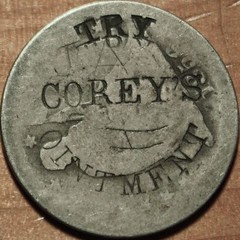
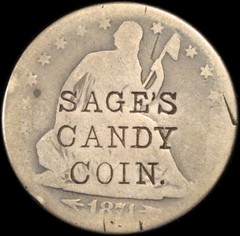
I recently studied and closely compared the letters in the TRY COREY'S OINTMENT and the SAGE'S CANDY COIN counterstamps in my collection. These two counterstamps share seven common letters, Y-E-C-O-I-N-S, (cool anagram, huh?). All appear to match in both letter size and style. The letters for both issuers measure exactly 3 mm in height. I would note that only the apostrophes differ in shape, but one apostrophe may have the slightest of damage. I believe that I may have previously mentioned a similarity, and now I'm convinced ... same maker.
The Sage piece is suspected to have been an issue from Buffalo, NY. For some time now, I've suspected that Dr. Medad S. Corey was the most likely issuer of the Corey's Ointment counterstamps. Dr. Corey attended medical school in Buffalo and settled with his practice about fifty miles west of that city. Coincidence? For me, a great part of the fun in collecting and studying counterstamps lies in the mystery and potential for solving a puzzle.
The saga continues.
To read the earlier E-Sylum articles, see:
MORE ON THE COREY'S OINTMENT COUNTERSTAMP
(www.coinbooks.org/esylum_v18n23a15.html)
NEW INFORMATION ON THE COREY'S OINTMENT COUNTERSTAMP
(www.coinbooks.org/esylum_v14n22a16.html)
THE BOOK BAZARRE
WEST POINT MINT MECHANIC SCOTT LACOURSE
Each department of the United States Mint supports the overall mission to serve the American people by manufacturing and distributing circulating, precious metal and collectible coins and national medals, and securing assets entrusted to the Mint.
The U.S. Mint at West Point, N.Y., manufactures gold, silver and platinum numismatic and bullion coins.
Maintaining and repairing the coin presses and related machines there is the responsibility of six electronic industrial controls mechanics.
Their key job elements:
- Maintain all equipment used in numismatic coin production, including 300-ton coin press, auto coin packaging machine, auto coin encapsulater, burnishers, and auto coin tubing machines.
- Skill in performing maintenance and repair operations on electronic systems and equipment.
- Ability to read and follow schematics, specifications, and precise technical instructions.
- Knowledge of techniques used in constructing electronic equipment applied to identifying defects or malfunctions in various parts, components, and assemblies.
- Maintain, repair, overhaul, and install electronic monitoring, indicating, and control systems used on industrial production machinery and 300-ton coin press.
- Install, repair, and maintain complete electronic industrial control systems and equipment of various types by performing the full range of diagnostic, modification, reconstruction and testing functions.
- Perform routine and preventive maintenance on systems, parts, assemblies, or components of moderate design, construction, and functional complexity. Identifies visible damage and wear, and performs repairs or replacements.
- Knowledge of electrical and electronic theory, including circuit design, transistor and solid state diode theory, and voltage and current comparison networks; knowledge of electronic and electrical block diagrams, wiring diagrams, and schematics; knowledge of pneumatic, hydraulic, mechanical, and electrical systems.
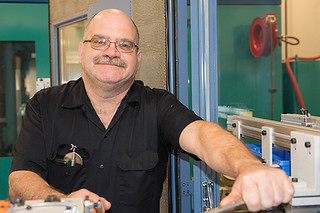 Scott Lacourse has worked in that job for four years, after previously performing machine repair, software upgrades, and maintenance of
industrial equipment.
Scott Lacourse has worked in that job for four years, after previously performing machine repair, software upgrades, and maintenance of
industrial equipment.
"You get to deal with a lot of people and unusual problems that you don't see every day," he said.
Lacourse said his most unusual project there has been removing and reinstalling an ejector arm for a Grabener coin press.
"We normally don't remove ejector arms. This one was removed to replace some worn cushion pads on the bottom that are not easy to get to," he said.
Lacourse, who enjoys skiing, hunting and camping in his off-duty time, explained why he likes working at the Mint.
"Every day presents a new challenge and opportunity to learn something different. Working at the Mint has enabled me to broaden my technical and troubleshooting skills. I work with a great bunch of people and look forward to the challenges ahead," he said.
The knowledgeable minds and skilled hands of electronic industrial controls mechanics keep coin presses in good working condition, ensuring all required production equipment is available when needed.
To read the complete article, see:
West Point Mint Mechanics Keep Coin Presses
Running (www.usmint.gov/pressroom/insidethemint/?action=west-point-mechanics)
FAIRBANKS COIN CLUB STRIKES HAMMERED COINS
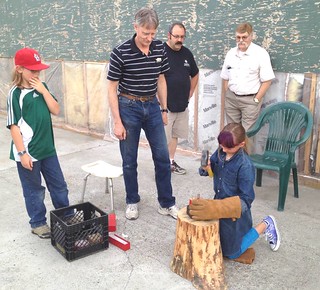 At the August 4th meeting of the Fairbanks Coin Club, President Mike Schmetzer gave a presentation on British hammered coinage. His
presentation revealed how the history of England could be traced through its hammered coins, from the early 600s AD to the late 1600s when they were
replaced by milled coinage.
At the August 4th meeting of the Fairbanks Coin Club, President Mike Schmetzer gave a presentation on British hammered coinage. His
presentation revealed how the history of England could be traced through its hammered coins, from the early 600s AD to the late 1600s when they were
replaced by milled coinage.
This presentation was followed by a demonstration of hand hammering coins (1 gram pure silver tokens). Club members had the opportunity to hand strike their own token. Dick Hanscom prepared the dies featuring a “long cross” and a few abbreviations of Latin terms for royalty. While not fully accurate, it reflects what might have been on a medieval coin.

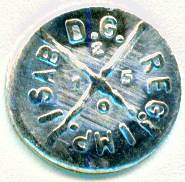
The long cross divides the token into quarters. Lettering is found inside each quarter as follows: ISAB / D.G. / REG. / IMP. Translated this would be Isabella (Mike’s daughter) / Dei Gratia (by grace of God) / Regina (queen) / Imperator (Empress). Also inside the quartered sections is the date 2015, arranged by clock positions 12-6-9-3.
The reverse has a star in the center, with SCHMETZLANDIA around the rim.
Two or three strikes with a 3# or 8# hammer resulted in their own token from Schmetzlandia.
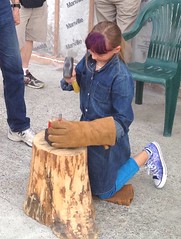
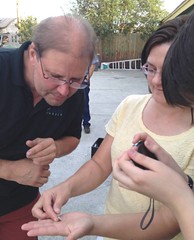

GREEKS EMBRACE ALTERNATIVE CURRENCIES
When Christos Papaioannou noticed his car needed new tires, the Greek computer engineer bought them with euros—but used an alternative currency, called TEM, to pay his mechanic for the labor.
His country has avoided a catastrophic exit from the common currency, at least for now. But a small but growing number of cash-strapped Greeks, who are still grappling with strict money-withdrawal limits, have found another route in TEM and other unconventional payment systems like it.
“Money is sparse right now, but people still have the same skills and knowledge they had before the crisis,” said Mr. Papaioannou, part of a cooperative that founded TEM in the port city of Volos and one of nearly 1,000 registered users of the alternate currency there.
TEM—a sophisticated form of barter whose name is the Greek acronym for Local Alternative Unit—was founded in 2010 in the early months of Greece’s debt crisis with less than a dozen members. Now it includes dozens of participating local businesses that use the system to sell goods and services, including prepared food, haircuts, doctor visits, or even for renting an apartment.
One of the larger and more established alternative payment systems in Greece, TEM has given Greeks living under the strain of wage cuts and tax increases a supplementary way to trade. Instead of dealing with a physical currency, members have an online account that starts at zero when they join. They can opt to take payment for goods and services in TEM, and then use those to buy products from others.
On the network website, users can post ads on what they can offer and what they want. Mr. Papaioannou, for instance, accepts TEM as payment for the computer repairs he does and says he uses the alternate currency in transactions several times a week.
It is a localized version of what Greece might have to turn to if a tentative bailout agreement reached this week is derailed, or ultimately fails. Before his resignation last month, former Finance Minister Yanis Varoufakis floated the idea of setting up a parallel-currency system based on IOUs in the event that Greece could no longer stay afloat using euros. Without a rescue, the idea of using IOUs is seen as the country’s most likely alternative.
The number of such alternate-currency projects began swelling in Greece in 2009, according to Irene Sotiropoulou, a Greek economist. That was the year the country’s budget deficit mushroomed to 15% of gross domestic product and investor appetite for Greek bonds collapsed.
Experts say TEM and other local currencies work best side-by-side with the euro, not as a replacement.
“They aren’t going to overhaul the financial system,” said Leander Bindewald, a researcher at the Institute for Leadership and Sustainability at the U.K.’s University of Cumbria. “But they represent a certain kind of value that normal money just cannot give you.” Users of the alternative currencies often cite the sense of community it provides as an additional benefit, saying they like the cooperation and social interaction it provides.
One notable example of alternative currencies used during a crisis was in the 1930s during the Great Depression, when the Austrian town of Wörgl decided to fight the economic downturn by printing its own money. Economists called the result a miracle: Employment boomed, while inflation remained subdued. During the economic depression that struck Argentina in 1998 and lasted till 2002, people formed barter networks and several provinces introduced their own currencies.
In the wake of the 2008 financial crisis, similar projects have been introduced to Spain, Italy, Portugal, Germany and France.
To read the complete article, see:
Alternative
Currencies Flourish in Greece as Euros Are Harder to Come by
(www.wsj.com/articles/alternative-currencies-flourish-in-greece-as-euros-are-harder-to-come-by-1439458241)
THE BOOK BAZARRE
COUNTY ADAPTS TO INTAGLIO PAPER SHORTAGE
People in Stanislaus County are being directed to different offices to obtain birth, as well as death certificates, because of a shortage of special paper for those records.
The shortage of secure paper for certified copies of vital records could create extra hassles for people in the next several months, whether it’s parents who need birth records for their children or a family settling a loved one’s estate.
Clerk-Recorder Lee Lundrigan has arranged to provide a “verification of birth” at no charge to parents who need to enroll children in school. She said she spoke with county schools Superintendent Tom Changon and sent letters notifying school districts, and no one has said the record of births from the clerk-recorder’s office are not acceptable.
Customers seeking birth or death certificates from the clerk-recorder will be directed to the county public health department or the California Department of Public Health. Lundrigan expects the restrictions will continue for three months until the special paper is provided by a new supplier.
Some counties in California have run out of “secure bank note paper” after their sole supplier, Sekuworks LLC of Ohio, suddenly closed in July. California is among states that adopted the “intaglio” method for printing certified copies of birth, death and marriage certificates. The states use paper with printed security features to prevent counterfeiting of vital records.
To read the complete article, see:
Stanislaus County clerk-recorder redirects people seeking birth, death
certificates (www.modbee.com/news/article30965163.html)
To read the earlier E-Sylum article, see:
OHIO INTAGLIO SECURITY PRINTING FIRM SEKUWORKS CLOSES
(www.coinbooks.org/esylum_v18n31a27.html)
QUERY: MAJOR CURRENT NUMISMATIC ORGANIZATIONS SOUGHT
This list of major numismatic organizations is to appear in my book Numiscadero, the Spanish-English and English-Spanish numismatic dictionary. It is a list of major groups, because some cities are larger than certain nations. Googling any of these group names should take you to a current website. Can anyone help with additional large groups or specialized groups of numismatic associations? Are any of these now defunct? I can be reached at Segovia.gary@Yahoo.com
- Aluminum Coin Collector's Society Founded in 2011 to promote the knowledge, appreciation and collecting of aluminum coins, medals and tokens from around the world.
- American Antiquarian Society This U.S. group has an online catalogue of its collection of more than 350,000 U.S. history records called ISAIAH
- American Institute for Conservation of Historic and Artistic Works The only national group in the USA with preserving cultural material and setting standards, promoting research, educational opportunities and knowledge. It has 3,500 members and was founded
- American Israel Numismatic Association A group with 700 members around the world. Its newsletter the Shekel, printed its 250th edition in late 2013.
- American Medallic Sculpture Association (AMSA) Founded in 1982 to encourage the field in North America as a vital and viable art form.
- American Numismatic Association The world's largest organization of coin collectors and dealers. It is a non-profit organization, chartered by an Act of Congress in 1912. 818 N. Cascade Ave., Colorado Springs, CO 80901.
- American Numismatic Society (ANS) A nonprofit educational organization of coin collectors and dealers. Established in the mid 1800s it promotes the study of coin collecting.
- American Political Items Collectors A collector group founded in 1945.
- American Vecturist Association. A U.S.-based group for collectors of transportation related tokens, which would include parking, and car wash items.
- Ancient Coin Collectors Guild A group that wants collectors to legally acquire and hold any numismatic items regardless of dates or places of origin. It was formed for ancient coin collectors on international political issues that threaten the hobby.
- Asociación Numismática Española The Numismatic Association of Spain.
- Asociación Española de Numismáticos Profesionales A coin dealer group in Spain that presents bourse shows 11 months of the year in cities including Madrid, Barcelona, Valencia, Sevilla, Segovia, Málaga, Vigo, Alicante, Bilbao, and Zaragoza.
- Associação Numismática Brasileira The national numismatic organization of Brazil.
- Association of Cuban Numismatics A group based in Havana, Cuba.
- Association des Collectioneurs de Jetons-Monnaie (CJM) of France. The French token collectors association.
- Barber Coin Collectors' Society A group interested in the coins designed by Charles E. Barber, Chief Engraver of the U.S. Mint 1879 -1917.
- British Art Medal Society A group that has commissioned medals from many distinguished contemporary sculptors of Great Britain.
- British Ephemera Society A group formed in 1975 with areas of interest that includes some numismatic items.
- Canadian Association of Wooden Money Collectors (CAWMC).
- Casino Chip & Gaming Token Collectors Club Founded in 1988 in the USA. Before the 1980s, chips and tokens could be found outside of casinos only as oddities. Items now collectable include poker chips, casino chips, antique gaming chips, dice, match books, ashtrays, postcards, coasters, menus, plaques, silver strikes, casino signs and slot machines.
- Central American Numismatic Association A group with conferences and reports.
- Central States Numismatic Society formed in Chicago in 1939.
- China Numismatic Society In the first decade it only dealt with Chinese coins. With increased international contacts since 1997, more foreign interests were formed.
- Chopmark Collectors Club An organization with about 300 members world-wide who collect chopmarked coins and maintain a website.
- Combined Organizations of Numismatic Error Collectors of America (CONECA)
- Conder Token Collector's Club For British provincial tokens of the late 1700s, named after James Conder. These items can include British and Irish tokens 1787-1804.
- Cuban Numismatic Association, founded in 2004 to encourage, promote and disperse Cuban numismatic knowledge, culture, education and fraternal relations.
- Ephemera Society of America formed in 1980 with areas of interest that includes some numismatic items.
- Florida United Numismatists (FUN) Presenters of the FUN Show considered one of the top coin conventions in the USA.
- Global Lottery Collector's Society Collectors of colorful lottery tickets. Some 43 U.S. states have lotteries, as do countries across the world.
- Haïtian Numismatic Society Haïti's colorful history is proudly reflected in its numismatics.
- Hellenic Numismatic Society publish an excellent annual journal, Nomismatika Kronika, all aspects of Greek numismatics, especially ancient Greek coinage. about 400 members around the world
- International Bank Note Society (IBNS) An association formed In 1961 for banknote collectors. It has thousands of members from around the world. Its Arabic Chapter has published books about the banknotes of Egypt, Kuwait and Libya.
- International Organization of Wooden Money Collectors (IOWMC),
- International Olympic Numismatic Federation. Fédération Internationale de Numismatique Olympique", or FINO, was founded by the IOC in 1993 in Lausanne, Switzerland to promote the collecting and study of coins, bank notes, medals and tokens tied to the Olympics. A small but dedicated group of people in the world collect Olympic medals although few medal winners want to part with their prizes. Olympic memorabilia dealers help, one of whom auctions 20 to 30 medals a year.
- New York Numismatic Club Normally we list only national or international level associations, but NYC, the largest city in USA, is 10 million people and has been around since 1909.
- Numismatic Association of Costa Rica A collector group in Central America.
- Numismatic Bibliomania Society A non-profit organization promoting numismatic literature. See the web site at coinbooks.org.
- Numismatic Education Society of Canada A group based in Victoria, BC Canada
- Orders and Medals Society of America (OMSA) Collector of military and heraldic medals.
- Organization of International numismatics
- Oriental Numismatic Society An association based in the UK, with members around the world. In 2009 it published its 200TH quarterly journal.
- Original Hobo Nickel Society A U.S. group interested in carved ‘buffalo’ 5 cent coins.
- Philippine Collectors Forum (PCF). It will be the first ever forum of its kind and held during the 2003 ANA Convention in Baltimore
- Professional Numismatists Guild An group of Numismatic dealers founded in 1955. The membership is restricted by financial and longevity requirements.
- Royal Canadian Numismatic Society The national organization for the hobby in Canada. Headquarters in Markham, Ontario. Canada L3P 1B4.
- Royal Numismatic Society The main collector and dealer organization of Great Britain. Founded in 1836 in London, it is international in scope and membership covering ancient, Asian, Medieval and Modern coins, paper money, tokens and medals. Its journal, the Chronicle, began in 1837.
- Royal Numismatic Society of New Zealand
- Russian Numismatic Society (RNS). A U.S.-based club for collectors of Russian coins.
- So-Called Dollar Collectors Club A U.S. group formed by 60 collectors in 2004.
- Sociedad Chilena de Estudios Numismáticos Chile’s numismatic association.
- Sociedad Numismática de México This group’s journal "El Boletín" is a Spanish & English since the club’s founding in 1952.
- Society of Paper Money Collectors A active group of banknote collectors in the U.S.
- Society of Thames Mudlarks A metal detecting group of coin hunters in England.
- Society of Ration Token Collectors A USA group that produced a catalog of ration tokens
- SOURCE, Student Organization for Unique and Rare Collections Everywhere. A group that builds connections with librarians and other professionals in the field.
- Southern California Orders & Medals Society (SOCALOMS)
- Swiss Numismatic Society (SNS) The main Swiss association of individuals and institutions interested in numismatics. Offices in Bern and Zurich. It was founded in 1879.
- Thames and Field metal detecting society. A club for mudlarking on The River Thames. thamesandfield.com
- The 1715 Fleet Society A group that studies the great sea disaster of colonial Spanish America. Commerical ??????
- Token & Medal Society (TAMS) A non-profit organization that furthers the exonumia field with all forms of tokens, medals, badges and other items of a related nature.
- United States Mexican Numismatic Association Founded in 1977, Its quarterly publication is the Mexican Numismatic Journal.
ARCHITECT CHARLES ZELLER KLAUDER AWARD MEDALS
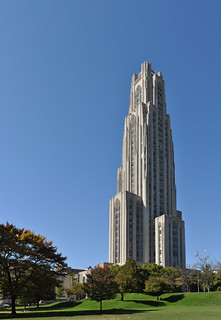 A TRIO OF AWARD MEDALS TO THE ARCHITECT, CHARLES ZELLER KLAUDER. According to Wikipedia, Charles Zeller Klauder (1872 – 1938) was an
American architect best known for his work on university buildings and campus designs, especially his Cathedral of Learning at the University of
Pittsburgh, the first educational skyscraper. For his lifelong architectural work, Klauder has received the Gold Medal, Architectural League, N.Y.
1921; Grand Prix Pan American Congress of Architects, 1927; Architectural Medal, Olympic Games, 1928. Klauder was a Fellow of the American Institute
of Architects. In 1938 he was elected into the National Academy of Design as an Associate Academician. Klauder, with Herbert C. Wise, was the author
of College Architecture in America.
A TRIO OF AWARD MEDALS TO THE ARCHITECT, CHARLES ZELLER KLAUDER. According to Wikipedia, Charles Zeller Klauder (1872 – 1938) was an
American architect best known for his work on university buildings and campus designs, especially his Cathedral of Learning at the University of
Pittsburgh, the first educational skyscraper. For his lifelong architectural work, Klauder has received the Gold Medal, Architectural League, N.Y.
1921; Grand Prix Pan American Congress of Architects, 1927; Architectural Medal, Olympic Games, 1928. Klauder was a Fellow of the American Institute
of Architects. In 1938 he was elected into the National Academy of Design as an Associate Academician. Klauder, with Herbert C. Wise, was the author
of College Architecture in America.
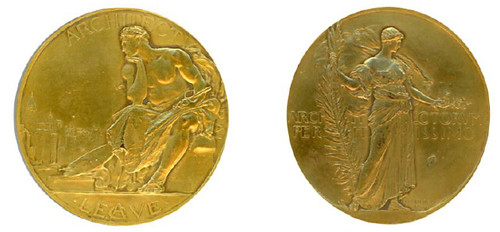
A. ARCHITECTURAL LEAGUE OF NEW YORK GOLD MEDAL FOR ARCHITECTURE, 1921, 63.5mm. Gilt Bronze. Hermon MacNeil, Sc. Baxter 351. Struck by Medallic Art Company, but unmarked. Edge engraved: Charles Z. KLAUDER 1921. XF/AU. On the reverse, there is a dig in the lower right field below the second S in PERITISSIMO. Obverse with a seated figure of a muscular bare chested man resting his chin in his hand and contemplating the NYC skyline. ARCHITECTVRAL above. LEAGUE in the exergue. On the reverse is a robed standing female figure holding a palm branch. To either side of her is a two line inscription: ARCHITECTORVM/ PERITISSIMO. Similar medals also exist for Painting and Landscape Architecture and sculpture. $325.00
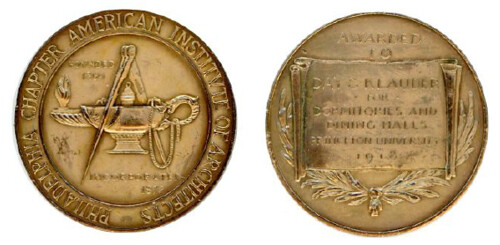
B. PHILADELPHIA CHAPTER AMERICAN INSTITUTE OF ARCHITECTS AWARD MEDAL, 1918. 50.5mm. Bronze. Unsigned. XF; the edge a little bit rough on top and with some dark tarnish on the reverse as shown. Obv: PHILADELPHIA CHAPTER AMERICAN INSTITUTE OF ARCHITECTS around their logo of a pair of dividers over a lamp of learning, Rx: AWARDED/ TO over scrolled inscribed: DAY & KLAUDER/ FOR/ DORMITORIES AND/ DINING HALLS/ PRINCETON UNIVERSITY/ 1918. This award was announced by the Philadelphia Chapter in a statement that read, "Architects Day and Klauder of Philadelphia were awarded the medal and diploma of the Philadelphia Chapter of the American Institute of Architects for the best example of executed work by a member at the annual exhibition of the Chapter and the T Square Club The design was the Princeton Dormitories and Dining Hall." $87.50
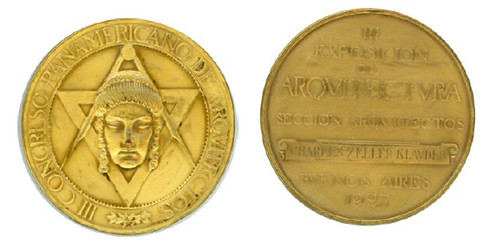
C. PAN-AMERICAN CONGRESS OF ARCHITECTS GRAND PRIX MEDAL, BUENOS AIRES, 1927. 59.2mm. Copper Gilt. Unsigned. XF. Several minor edge dents. Obv: III CONGRESO PANAMERICANO DE ARQVITECTOS around a sunken inner circle containing a female head representative of Architecture over a pair of dividers and a triangle. Rx: III/ EXPOSICION/ DE/ ARQVITECTVRA/ SECCION ARQVITECTOS/ a rectangular cartouche inscribed: CHARLES ZELLER KLAVDER/ BUENOS AIRES/ 1927. $97.50
THE BOOK BAZARRE
PIGEON DICKIN MEDAL WINNER EXHIBIT
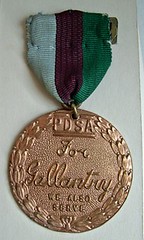 A lasting tribute to a pigeon which helped save lives and win a war has winged its way to the bird’s home village.
A lasting tribute to a pigeon which helped save lives and win a war has winged its way to the bird’s home village.
Blue chequer hen Winkie became an animal Victoria Cross recipient after helping to save the stranded crew of an RAF bomber after it crashed in the icy North Sea at the height of World War II.
The bird had been a carrier pigeon for the service and followed her training when she escaped from her container in the impact of the crash as the Beaufort Bomber hit the sea between Norway and Scotland on the night of February 23, 1942.
She flew home, alerting her owner who contacted the RAF, which then deduced where she had flown from based on her bedraggled condition and weather conditions.
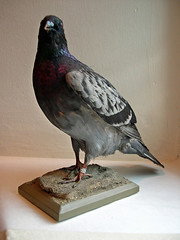 The crew were saved after they were found in their rubber dingy.
The crew were saved after they were found in their rubber dingy.
Her heroics earned Winkie, who was bred on Bents Farm in Whitburn, the Dickin Medal, the animal equivalent of a VC.
With radio silence essential, RAF crews used tens of thousands of birds to send messages and microfilm, with the animals reliable and able to make their journeys undetected.
Now, she has been given a lasting memorial in the village, with a display entitled Winkie Comes Home to Whitburn installed in Latimer’s cafe in the village.
To read the complete article, see:
Victoria Cross hero pigeon Winkie honoured with memorial to bird’s RAF rescue mission
(www.sunderlandecho.com/news/local/all-news/victoria-cross-hero-pigeon-winkie-honoured-with-memorial-to-bird-s-raf-rescue-mission-1-7409807)
A NORSE-AMERICAN MEDAL NECKLACE
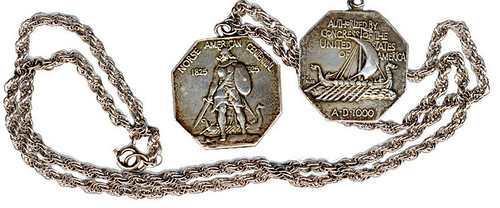
The famous 1925 Norse-American medals are the work of James Earle Fraser of Buffalo nickel fame. As a youngster I remember the first time I ever looked into a dealer’s case and saw a 1925 Norse-American medal. It was large, octagonal, and had a really neat and appealing Viking design. Back in the 1960s the medals were not overly expensive, but another coin, probably a Liberty Seated dime, must have caught my attention that day and the Norse-American medal was forgotten.
Over the years I came in contact with many of the pieces, but I never seemed to connect, as coins always came first. Several years ago when silver was lingering at about $6 to $8 an ounce, I came across the Norse-American medal featured here in a New York State coin shop. When I asked the price, the dealer threw it on his scale and quoted me melt value. I don’t remember the cost, but it weighs 35 grams and I was charged accordingly.
The chain is stamped “sterling” and makes a great complement to the actual medal. Deep silver-gray with golden highlights, the thick planchet piece I own -- they come on thin planchets as well -- grades EF or so due to its use as jewelry. It sits on my royal purple velvet desktop tray at work along with numerous other exonumia items, and every now and then I flip the medal so I can enjoy each of the Viking designs -- the warrior on one side and the longboat on the other. And, as far as I’m concerned, I don’t need to own another 1925 Norse-American medal; my “desktop” model does the job just fine!
To read the complete article, see:
“I always wanted a Norse-American medal…” (www.stacksbowers.com/NewsMedia/Blogs/TabId/780/
ArtMID/2678/ArticleID/65302/%E2%80%9CI-always-wanted
-a-Norse-American-medal%E2%80%A6%E2%80%9D.aspx)

CHINA TO ISSUE NEW, MORE SECURE 100 YUAN NOTES
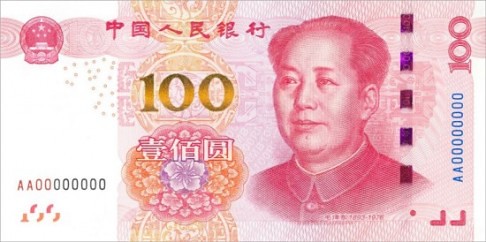
The new 100 yuan note design (front)
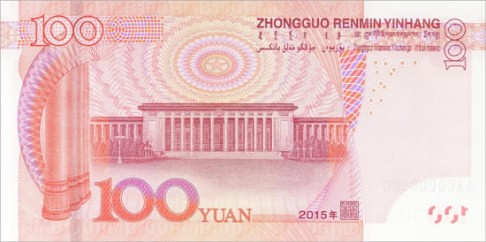
The new 100 yuan note design (back)
The People’s Bank of China is planning to issue a new 100 yuan banknote with improved anti-counterfeiting features in November, the first upgrade of the bill since 2005.
While the portrait of Mao Zedong will remain, the new notes will include features to combat counterfeiting, which is rampant.
The face value of seized counterfeit money on the mainland rose from 329 million yuan (HK$410.million) in 2012 to 532 million yuan last year.
The central bank said on Monday the note’s design had been updated so it could be more easily identified by vending machines and automatic teller machines, which have proliferated across the country.
The new note will be the third edition of the fifth series, which was introduced in 1999. The second edition was issued in 2005.
Its look will stay largely the same as the second edition except for changes to the colour and design of some graphic elements.
Colour-changing ink will be applied to the pattern of the number 100 in the centre of the note to make it more difficult to counterfeit. The colour will change from golden to green when the angle is adjusted.
New notes will feature additional serial numbers on the right-hand side to ensure they are still identifiable even if the serial number on the left has worn off.
Other new features include a security line on the right of the bill, which will change from hot pink to green when the viewing angle is adjusted, and a textured pattern across the image of the Great Hall of the People on the back of the note.
To read the complete article, see:
China to issue new
100 yuan note to counter the counterfeits
(www.scmp.com/news/china/society/article/1848161/china-issue-updated-100-yuan-banknote-design-november)
THE FIRST MONEY-PRINTING FACTORY IN VIETNAM
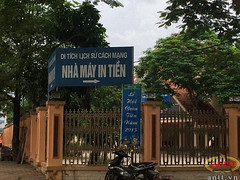 in Hoa Binh Province, tourists can visit the first money-printing plant in Vietnam, named Chi Ne, where they can see the first banknotes
issued by the Vietnam Democratic Republic in 1946.
in Hoa Binh Province, tourists can visit the first money-printing plant in Vietnam, named Chi Ne, where they can see the first banknotes
issued by the Vietnam Democratic Republic in 1946.
To develop the first money printing plant, credit should be given to patriotic capitalist Do Dinh Thien. In the early years of independence, the country fell into difficulties when the budget was exhausted.
The government decided to set up a money printing factory for the Ministry of Finance to issue banknotes of the independent Vietnam. At that time Thien spent a fortune to purchase the Hanoi-based Taupin Printing House, one of the two largest and most modern printing enterprises in Vietnam. He donated it to the government.
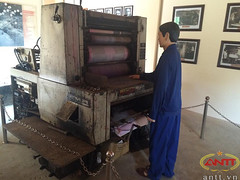 The Ministry of Finance then moved part of the factory to Chi Ne plantation, which was also owned by Thien.
The Ministry of Finance then moved part of the factory to Chi Ne plantation, which was also owned by Thien.
The first banknotes of independent Vietnam were not beautiful and the quality was not good but the people were very enthusiastic because they represented independence, freedom and national sovereignty.
On the banknotes was the portrait of President Ho Chi Minh. The first banknotes became a weapon of struggle on the economic and financial front and a way of rejecting the Indochina banknotes of the French.
The banknote with the largest value was VND100, which was called the "green buffalo" banknote as it had a picture of a buffalo on it. This factory has become a relic site since 2010.
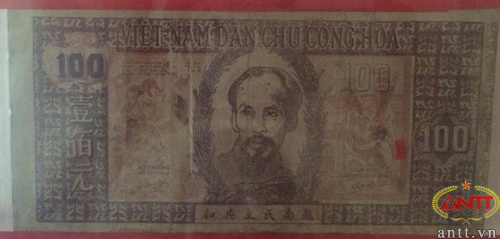
To read the complete article, see:
Inside Vietnam’s first
money-printing enterprise (http://english.vietnamnet.vn/fms/travel/137568/inside-vietnam-s-first-money-printing-enterprise.html)
WALL STREET JOURNAL COVERS EMPEROR NORTON I
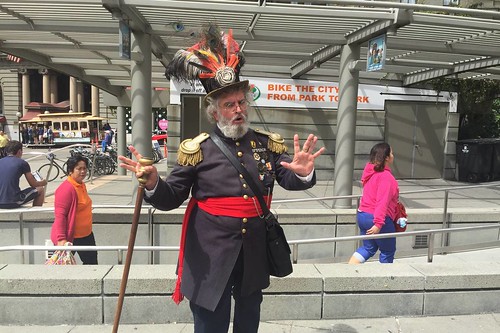
Joseph Amster Channels Norton I,
"Emperor of the United States and Protector of Mexico."
Wearing a top hat festooned with multicolored feathers, Joseph Amster stopped in front of a Ghirardelli Chocolate Co. store on bustling Market Street and began shouting at the shop’s bemused clientele through its large glass windows.
“Look at them! Ignoring me! Mocking me! They have not heard the last of me!” Mr. Amster exclaimed, the feathers quivering with his wild gesticulations. “I will issue a special proclamation demanding they bring back my sundae!”
Patrons likely had no idea what he was talking about. But Mr. Amster was playing the role of this city’s most celebrated 19th-century eccentric: Norton I, the self-styled “Emperor of the United States and Protector of Mexico.”
Mr. Norton’s was once a household name here. Numerous things were named after him, including Ghirardelli’s Emperor Norton Sundae. But the sundae, like Mr. Norton in general, has since faded from view.
Now some San Franciscans are pushing to return the emperor to prominence. Mr. Amster, 59 years old, who conducts tours dressed as Emperor Norton, is among those trying to bring him back, to rekindle the city’s celebration of society’s oddballs and outcasts.
Another admirer launched an effort to place the emperor’s sculpture in the city’s historic Portsmouth Square. Meanwhile, official-looking “Imperial Landmark” plaques dedicated to Mr. Norton have begun clandestinely appearing on various city corners.
It is a uniquely San Francisco movement, boosted partly out of fears that the influx of hipsters and wealthy Silicon Valley techies, spawning artisanal pop-ups and burgeoning multimillion-dollar condos, is erasing some of the city’s odd soul.
“The old-timers are attempting to reclaim something of San Francisco that appears to be going away,” said Jason Macario, of the San Francisco Museum and Historical Society.
Though his gravesite reads “1819,” debate over Mr. Norton’s life begins at birth, with some historians and fans saying he was most likely born in 1818.
Born in England and raised in South Africa, Joshua Abraham Norton was the archetypal San Franciscan, aficionados say, a hero who hailed from someplace else, succeeded in building a fortune here and then lost it in spectacular fashion. Mr. Norton’s downfall came from betting unsuccessfully that he could corner the market in rice.
A favorite interview for reporters of the era, Emperor Norton was famous for his assertions of supreme authority over the country, calls to dissolve Congress and pledges to impose fines on anyone heard calling the city “Frisco.”
Mr. Norton vanished after declaring bankruptcy in 1856. Then on Sept. 17, 1859, he walked into the offices of a local newspaper and brandished a letter proclaiming himself Emperor of the U.S. The editor printed it for fun, and San Franciscans kind of just ran with it.
For about 21 years, Mr. Norton lived as emperor, with some scholars saying his persona likely inspired the Mark Twain character of the king in “Adventures of Huckleberry Finn.”
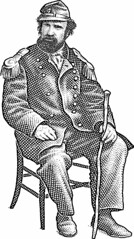 Mr. Norton was known for wearing an unusual assortment of uniforms, according to local historian Peter Moylan. For special occasions, he
would dress in a stained Union officer’s coat with gold epaulets, and a tall beaver hat with an ostrich plume, a cavalry sword at his hip.
Mr. Norton was known for wearing an unusual assortment of uniforms, according to local historian Peter Moylan. For special occasions, he
would dress in a stained Union officer’s coat with gold epaulets, and a tall beaver hat with an ostrich plume, a cavalry sword at his hip.
By the time he dropped dead on a street corner in 1880, his fame was so renowned he drew more than 10,000 mourners to his burial ceremony.
Some of the emperor’s various proclamations proved prescient. He defended the rights of minorities. He ordered the formation of a league of nations to settle disputes. And yes, he mandated building a bridge between San Francisco and Oakland.
“He came here to reinvent himself and the city embraced him in a way no other place in the world would have,” said Mr. Amster, who conducts his time machine tours in emperor garb for $20 a person. “It’s a story that happens here over and over again.”
To read the complete article, see:
Who Is Emperor Norton? Fans
in San Francisco Want to Remember (www.wsj.com/articles/who-is-emperor-norton-fans-in-san-francisco-want-to-remember-1439426791)
MAN BUYS SHEEP WITH COUNTERFEIT CASH
Abu Dhabi Police has arrested a Bangladesh national for buying two sheep from an Emirati woman with forged money.
The accused MM, 41, had chosen the best types of sheep from the 65-year-old woman.
In a statement, Abu Dhabi Police said the woman had been alerted by JS, Emirati, that he had sold two sheep in return for money in Dh100 notes which were found to be counterfeit.
Though the woman was unable to accurately describe the suspect, she could give good description of the two sheep, one of which was 'Najdi' and the other a brown, fat 'Naimi' with large horns.
The sheep's description helped the police to trace the animals. The arrested person was trying to sell the two sheep in a livestock market for Dh2,000.
The sheep were returned to the victim.
To read the complete article, see:
Man buys sheep with counterfeit
money (www.emirates247.com/crime/local/man-buys-sheep-with-counterfeit-money-2015-08-12-1.600111)
FEATURED WEB PAGE: SAGE’S CANDY COIN
This week's Featured Web Page is the North Carolina Numismatic Association's page on the Sage’s Candy Coin counterstamp.One counterstamp that has piqued my interest of late is the mysterious SAGES CANDY COIN mark found on some examples of 1870’s vintage, high-denomination U.S. coins. It was once believed that this counterstamp might be the subject of a 19th century confection related promotion. The odd thing is that this mark is found on quarters, half dollars and Trade Dollars making this a truly generous promotion for that era.
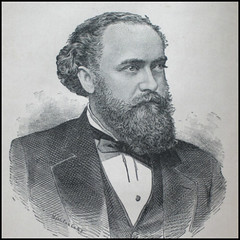
http://ncnaonline.org/starter.php?name=cappssage

